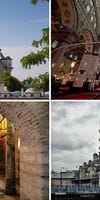The largest city in Turkey, Istanbul, is full of sights and interesting places, some of which the city has inherited since the time of the sultans.
Mosques, churches and cathedrals are singled out as a separate category of Istanbul attractions.
This article lists the significant, large and beautiful shrines of Istanbul, some of which have panoramic terraces and are used as viewing platforms.
If you want to know only about the main mosques and churches of Istanbul, which are the most significant, beautiful and visited, and which are worth visiting first, or if you don't have much time for Istanbul, then you can see the list Top shrines of the city here →
You can visit mosques, churches and cathedrals of Istanbul on your own or with city tours
Blue Mosque (Sultanahmet Mosque)
The Blue Mosque or Sultanahmet Mosque (Sultanahmet Camii / Sultan Ahmet Camii) is a historical imperial mosque, which is the first mosque in the city, and is also considered an outstanding example of Islamic and world architecture.
The mosque is known primarily for its six minarets and interior decoration, which is considered a masterpiece.
Today it is a functioning mosque, which is included in the UNESCO World Heritage List and attracts numerous tourists.
Entrance to the mosque is free (free).
The mosque is located in the central part of the European side of Istanbul, in Sultanahmet district, at the address: Sultan Ahmet, Atmeydanı Cd. No:7, 34122 Fatih/Istanbul, Turkey. More about the Blue Mosque...
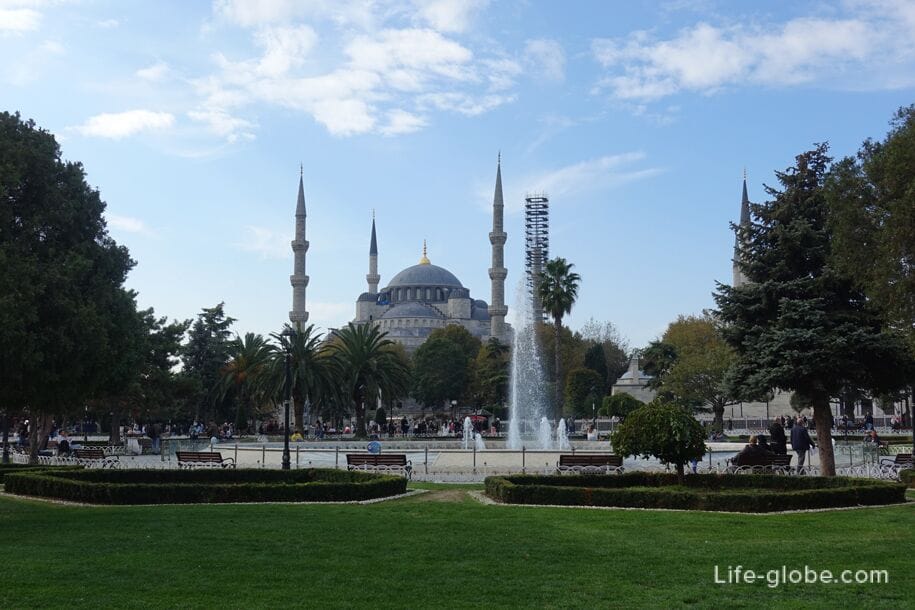
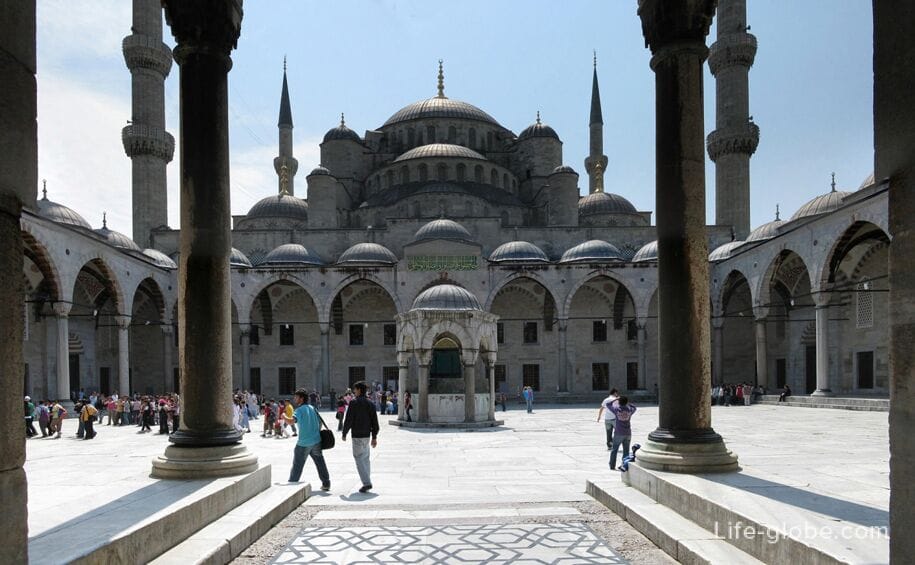
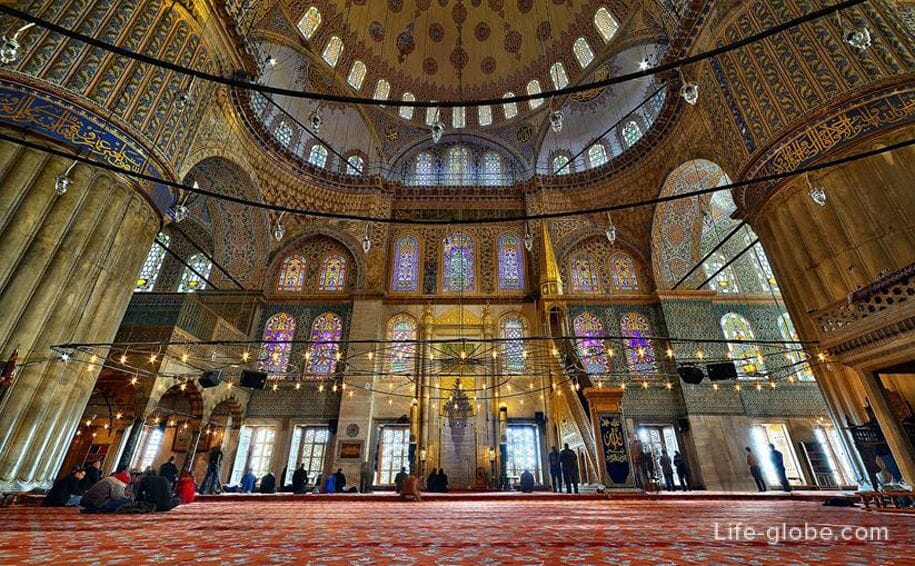
Hagia Sophia Mosque (Hagia Sophia)
Hagia Sophia or Hagia Sophia (Ayasofya) is a mosque in Istanbul, which during its history has been an Orthodox church, mosque and museum.
The mosque is one of the greatest world-famous monuments and examples of Byzantine culture, as well as a symbol of the "golden age" of Byzantium.
Hagia Sophia has mausoleums, tombs, four minarets, and the giant dome system of the mosque with arched windows is a masterpiece of architectural thought of its time.
The interior of Hagia Sophia has absorbed several cultures and religions: inscriptions in Scandinavian runes, unique Orthodox mosaics, Islamic mihrab, Sultan's lodge and minbar. The "Weeping Column" also attracts attention, which, according to legend, cures diseases and fulfills wishes.
Entrance to the mosque is free (free).
Hagia Sophia is located near the Blue Mosque, at the address: Sultan Ahmet, Ayasofya Meydanı No:1, 34122 Fatih/Istanbul, Turkey. More about the Hagia Sophia Mosque...
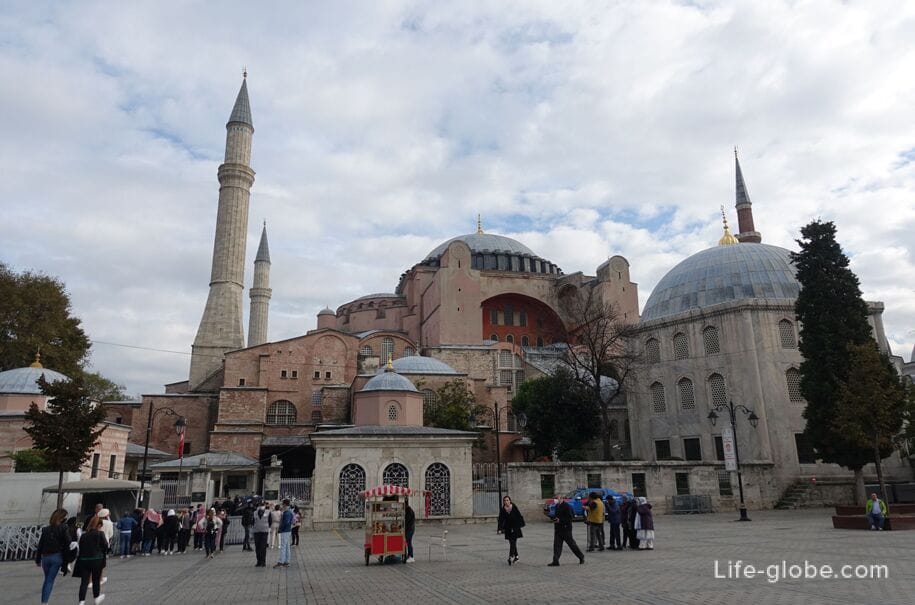

St. Irene's Church
The Church of St. Irene (Aya Irini, Aya-Irena) was built at the beginning of the 4th century on the site of the ruins of the ancient temple of Aphrodite under the Roman Emperor Constantine and was the main temple of the city before the construction of Hagia Sophia.
After the conquest of Constantinople in 1453, the church of St. Irene was not converted into a mosque and there were no significant changes in its appearance. During the 15th and 18th centuries, the church was used by the Ottomans as armories, and since 1846, it has been turned into a museum.
Entrance to the church-museum is paid.
The Church of St. Irene is located on the territory of the Topkapi Palace complex (Topkapı Sarayı). More about Topkapi Palace...
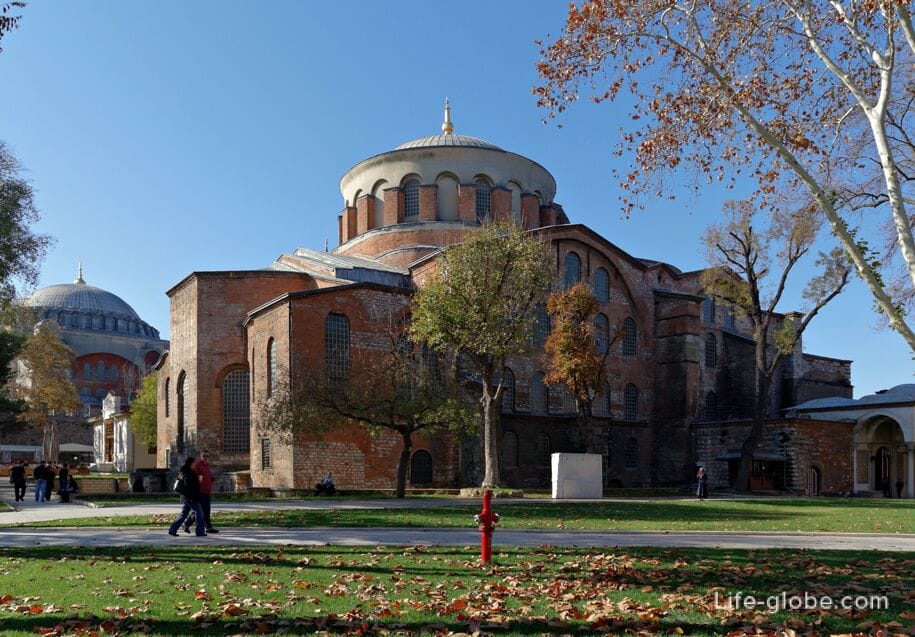
Firuz Agha Mosque
Firuz Agha Mosque (Firuz Ağa camii) is an Ottoman mosque of the 15th century, which was erected by Firuz Agha, the chief treasurer of Sultan Beyazit II.
This mosque is quite restrained in architecture and does not stand out in interior decoration. It has one minaret, a small courtyard and a marble sarcophagus of Firuz Agha.
The mosque is located in the center of the historical part of Istanbul, near the Blue Mosque and Hagia Sophia.
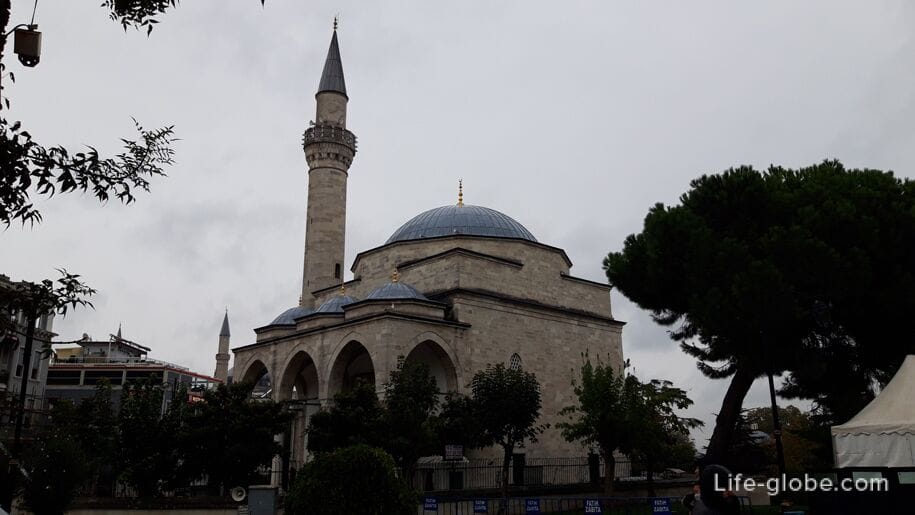
Sokollu Mehmed Pasha Mosque
The Sokullu Mehmet Pasha Mosque (Sokullu Mehmet Paşa camii) is a fairly large and well-known mosque of the city.
The mosque was built in the Ottoman style in 1572 on the site of the church of St. Anastasia, parts of the ruins of which were involved in the construction of the mosque.
The mosque is named after the Grand Vizier Sokollu Mehmed Pasha.
The mosque has one minaret and a courtyard. The interior of the mosque is known for Iznik tiles decorating the interior walls.
The mosque is located in the historical part of Istanbul, in the Kadirga (Kadırga) neighborhood.
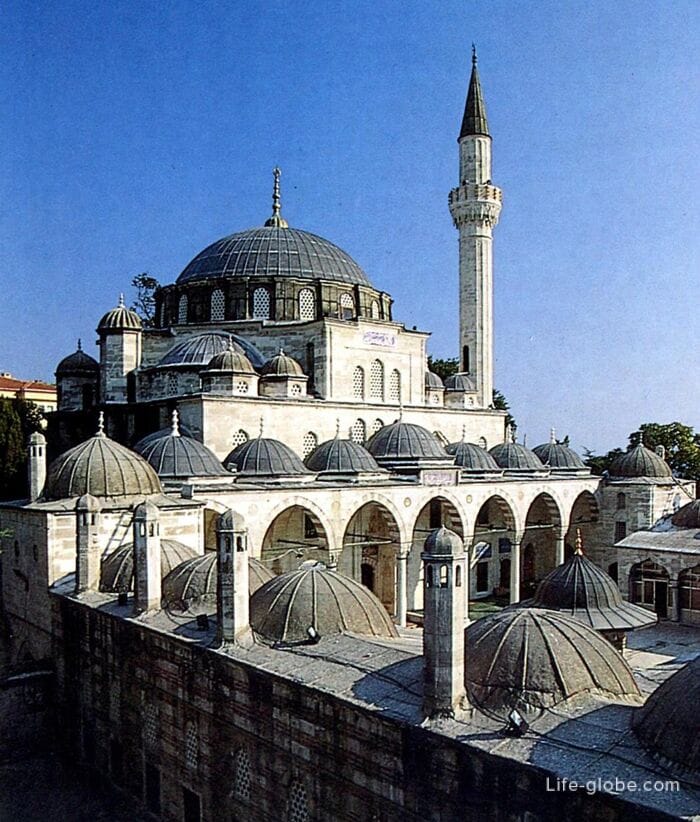
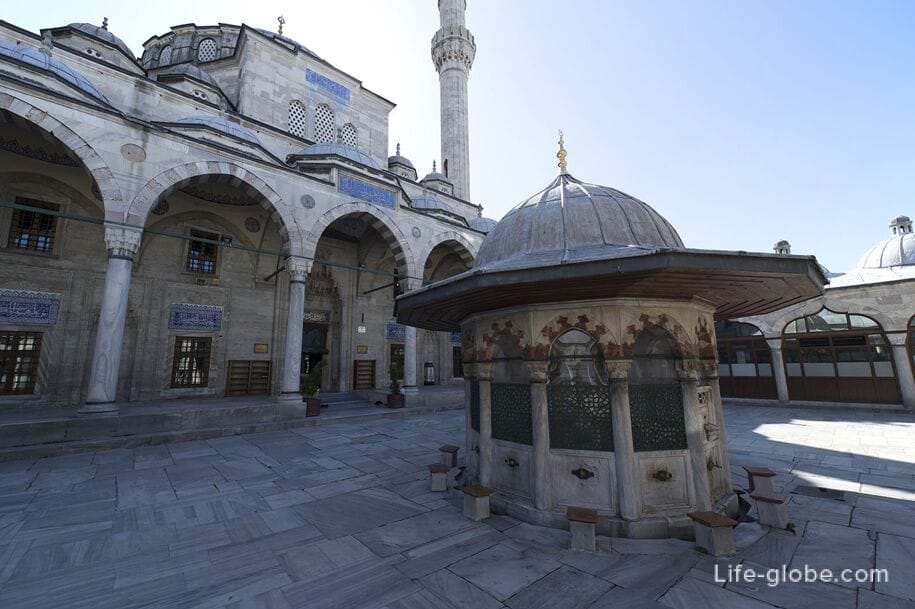
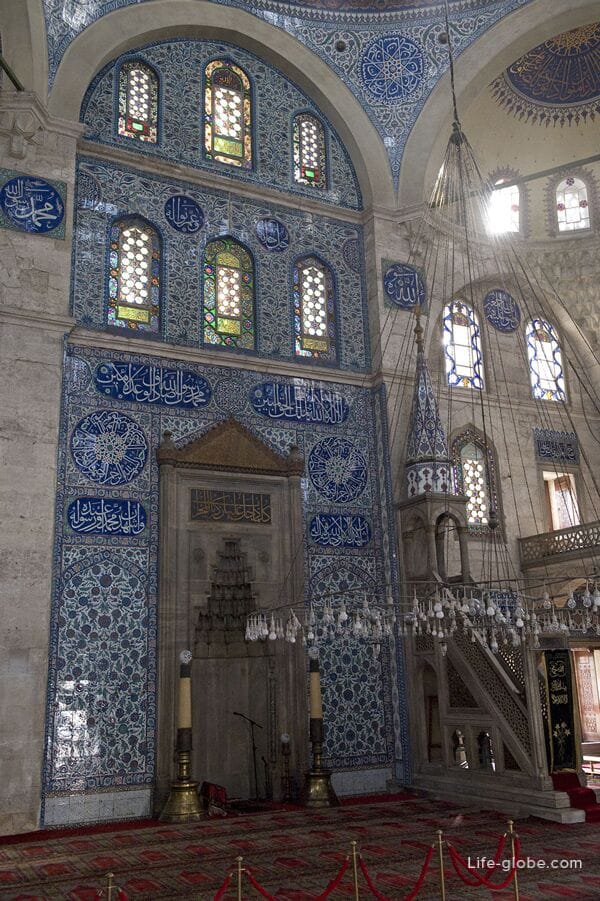
Church of Saints Sergius and Bacchus - Little Saint Sophia
The Church of Saints Sergius and Bacchus (Küçük Ayasofya) or Little Saint Sophia (Kuzuk Ayasofya Caddesi) is a mosque in the building of the 6th century Byzantine church, which the Byzantines named after Sergius and Bacchus.
Since the temple looks like the Hagia Sophia, only it is smaller, the people called the shrine "Kyuchuk Hagia Sophia", which means "Little Hagia Sophia" or "Little Saint Sophia".
It is one of the oldest preserved churches in Istanbul. The existing temple was built in 527-529 near the house where Emperor Justinian I spent his young years. The fact that the church of Saints Sergius and Bacchus was especially loved by the imperial family is evidenced by the fact that the initials of Justinian and Theodora are applied to many capitals.
After the fall of Constantinople, the church of Saints Sergius and Bacchus continued to operate until 1506, when it was converted into a mosque, where mosaics were whitewashed, a porch and a madrasah were added.
In 1742, a ritual fountain was built in the courtyard of the building, and in 1762 a minaret appeared (completely rebuilt in 1952). Sultan Mahmud II ordered the renovation of the mosque after repeated earthquakes.
The address of the church-mosque: Küçük Ayasofya Mahallesi, Küçük Ayasofya Camii Sokagi No:20, 34122 Fatih/Istanbul, Turkey.


Nurosmaniye Mosque
Nuruosmaniye Mosque (Nuruosmaniye Camii) is an Ottoman mosque of 1755 with a large dome and many windows, which is notable for its architecture.
The construction of the mosque was started in 1748-1749 during the reign of Sultan Mahmud I and completed in 1755 during the reign of Sultan Osman III.
The mosque was the first in the city built in the Baroque style of Ottoman architecture, which was influenced by European models.
The dome of the mosque is the fourth largest in Istanbul, after Hagia Sophia, Suleymaniye Mosque and Fatih Mosque.
The Nurosmaniye Mosque is a complex consisting of: a mosque, a madrasah, an imaret (dining room), a turban of Osman III's mother - Valide Shehsuvar Sultan, a library of manuscripts in Ottoman, Arabic and Persian languages and a fountain located at the entrance to Kapaly Charshi.
The mosque is located near the most famous historical bazaar in Istanbul - the Grand Bazaar (Kapalı çarşı). Learn more about the Grand Bazaar...
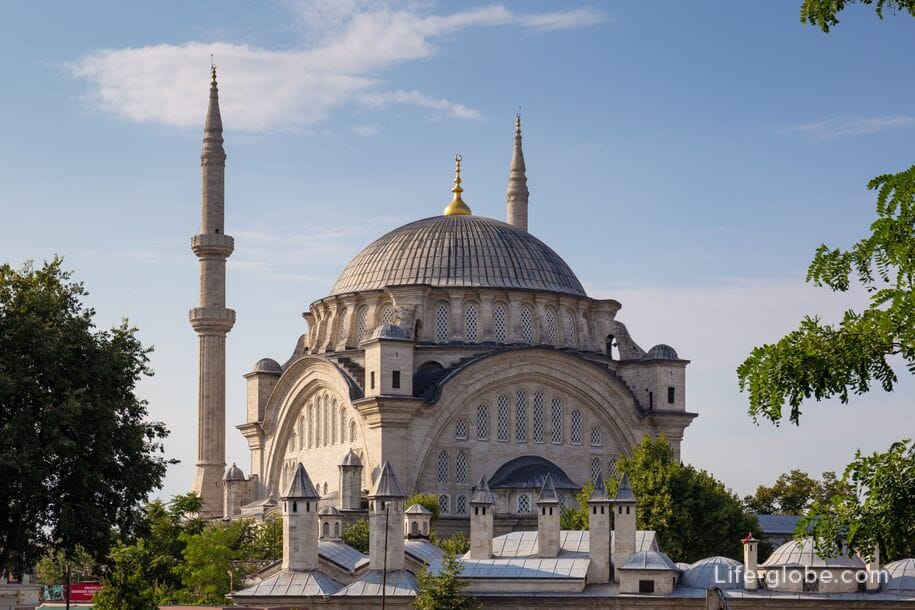

Baezid Mosque
The Bayezid or Bayazid Mosque (Beyazıt Camii) was built in 1500-1506 by order of Sultan Bayezid II and became the second major imperial mosque complex (after the Fatih Mosque) that appeared in Constantinople after its conquest in 1453.
The mosque has two minarets, the peculiarity of which is the distance from each other.
The mosque has preserved baths and madrasas, where the Istanbul Library is now located. The complex also includes a courtyard, which is accessed by monumental portals.
There is a small garden behind the mosque, where the turbe (crypts) of Sultan Bayezid II, his daughter Selchuk Sultan and Grand Vizier Mustafa Reshid Pasha are located.
The interior of the mosque is modeled after the Hagia Sophia, only on a smaller scale.
The mosque is located next to the Grand Bazaar.
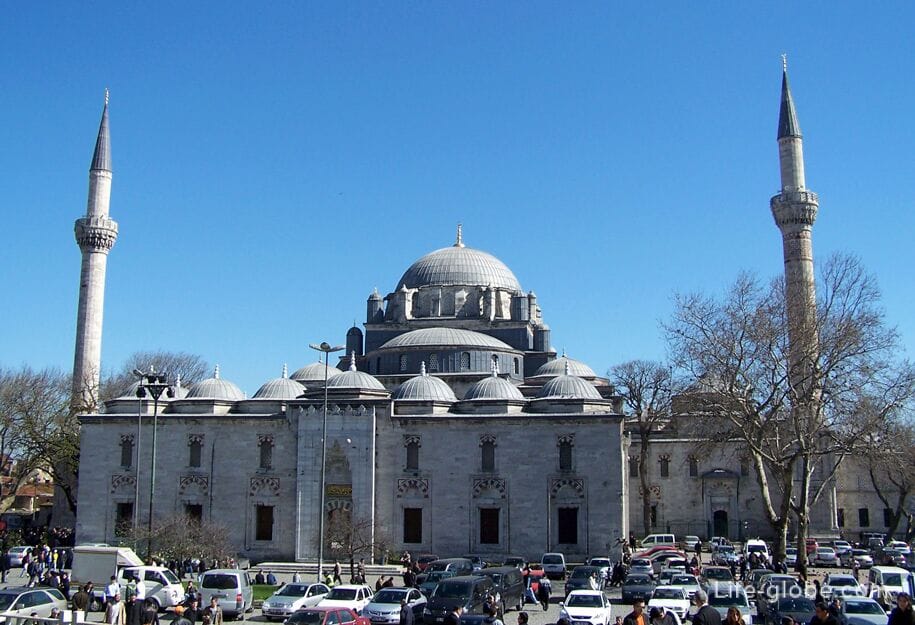
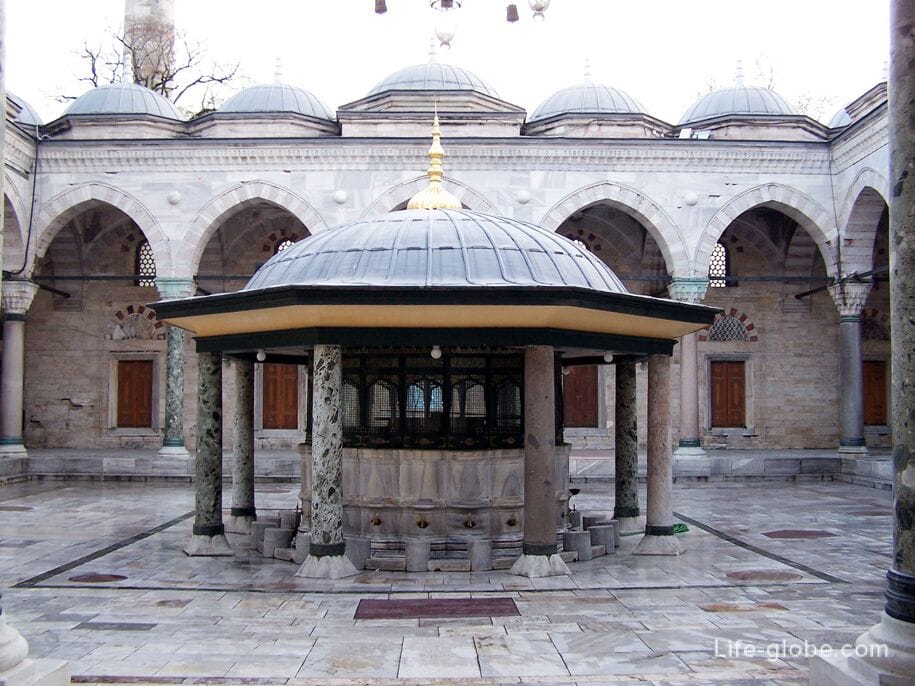
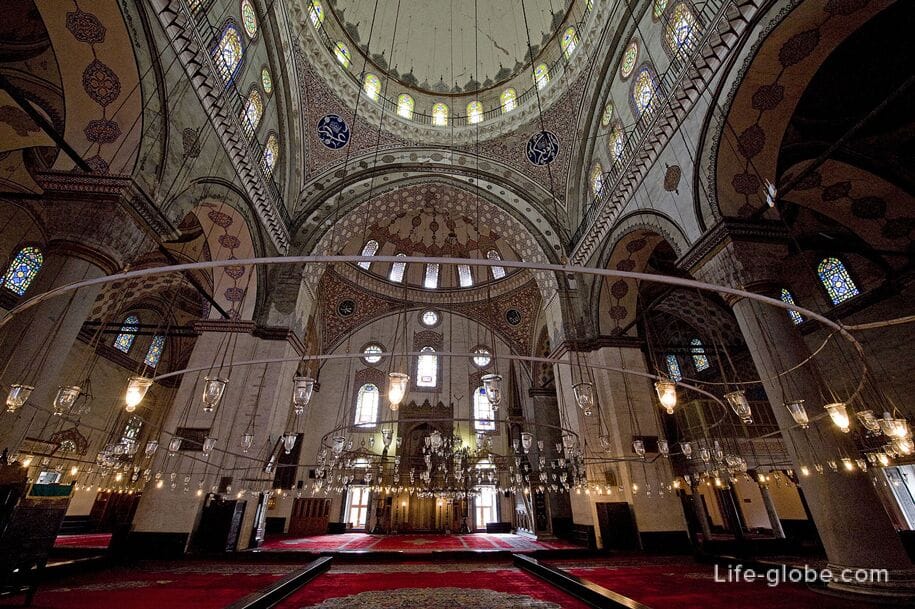
New Mosque
The new mosque (Yeni Cami, Yeni Jami) was originally called the Valide Sultan Mosque (Valide Sultan camii), and then the New Valide Sultan Mosque (Yeni Valide Sultan Camii).
The construction of the mosque as a complex was started in 1597 by order of Safiye Sultan, who was the wife of Sultan Murad III, and later Valide Sultan (Queen mother) of Sultan Mehmed III.
The appearance of this large mosque stands out against the background of the nearby buildings with 66 domes and semi-domes of pyramidal arrangement, as well as two minarets with three sherefe (balconies) on each. The mosque's windows are decorated with stained glass windows.
The mosque has a monumental courtyard (avlu), in the center of which there is a fountain for religious ablutions, but in fact the ritual of ablution is carried out from water taps near the southern wall of the mosque.
The new mosque is located in the old part of the city on the square of the same name in the Eminönü district near the Galata Bridge (Galata Köprüsü). Learn more about the Galata Bridge...



Rustem Pasha Mosque
The Rustem Pasha Mosque (Rüstem Paşa camii) was built in 1561 by order of Sultan Suleiman the Legislator's son-in-law, Grand Vizier Rustem Pasha.
The mosque has one minaret and is not particularly attractive from the point of view of architecture. But it is located on one of the main tourist routes in Istanbul - opposite the New Mosque and at the Galata Bridge.


Suleymaniye
Suleymaniye (Süleymaniye Camii) is a masterpiece of architecture of the Ottoman Empire and the second most important mosque in the city after the Blue Mosque.
The mosque was built in 1551-1557 by order of Sultan Suleiman the Magnificent and was built as a complex with adjacent buildings to serve both religious and cultural needs.
Suleymaniye is a complex in which, in addition to the mosque itself with a monumental courtyard, the turbe (tombs-mausoleums) are notable, which are polygonal buildings topped with a massive dome. Inside the tombs rest: Suleiman the Magnificent, his beloved wife Hurrem (Roksolana) and their daughter Mihrimah, as well as other members of the ruler's family.
Since the mosque is located on a hill, its territory offers panoramic views of part of Istanbul.
Mosque address: Süleymaniye Mah, Prof. Sıddık Sami Onar Cd. No:1, 34116 Fatih/Istanbul, Turkey.
Entrance to the mosque complex is free (free of charge). More about the Suleymaniye Mosque...
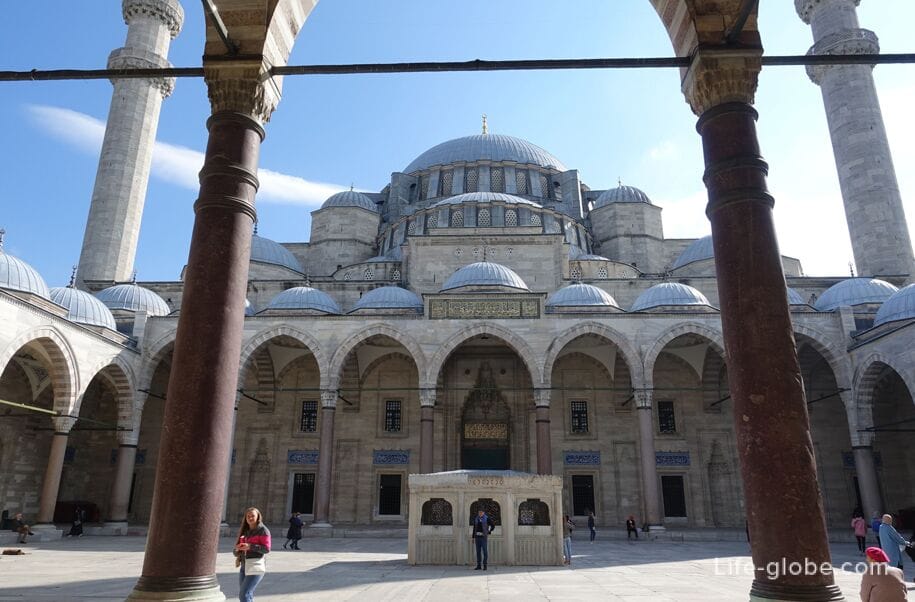
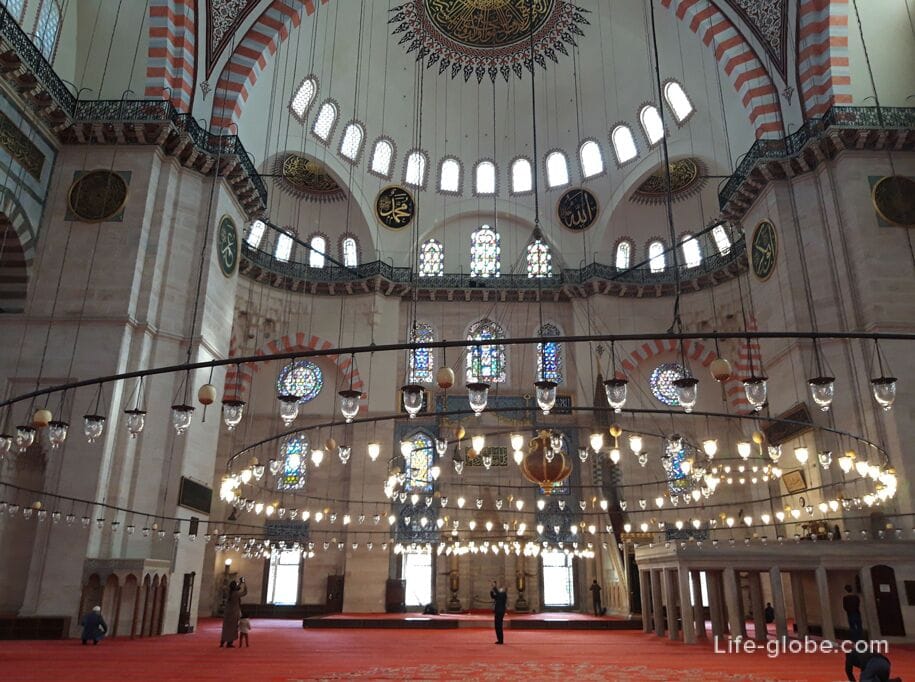
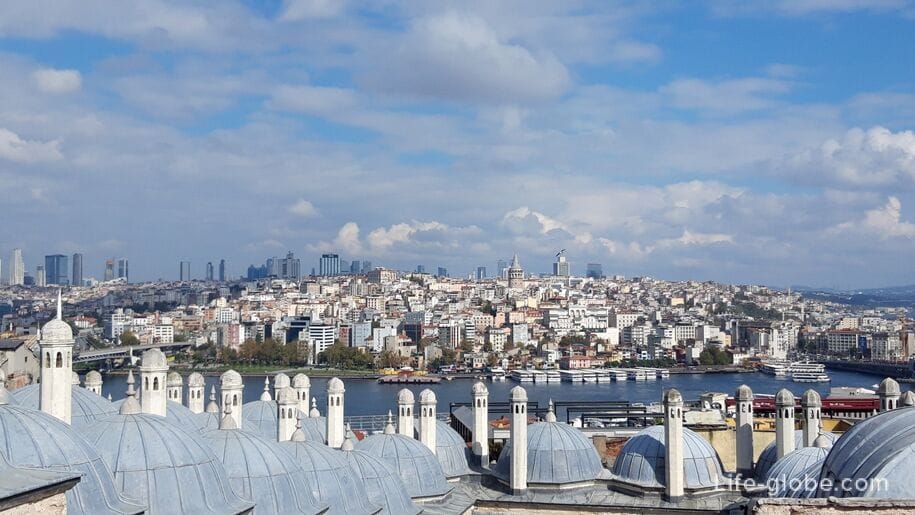
Shehzade Mosque
The Shahzade Mosque (Şehzade Cami) is also known as the Shehzadebashi Mosque (Şehzadebaşı Camii) or the Shehzade Mehmet Jami Mosque (Şehzade Mehmet Camii).
The mosque was built in 1543-1548, after the son of Sultan Suleiman the Magnificent, Shehzade Mehmed, died in 1543.
The mosque has two minarets with two balconies-galleries each, a large dome and a courtyard.
The turban of Shehzade Mehmed contains the graves of Shehzade Mehmed himself, his brother Shehzade Jihangir, as well as the daughter of Huma Shah Sultan.
The mosque is located in the historical center of Istanbul.
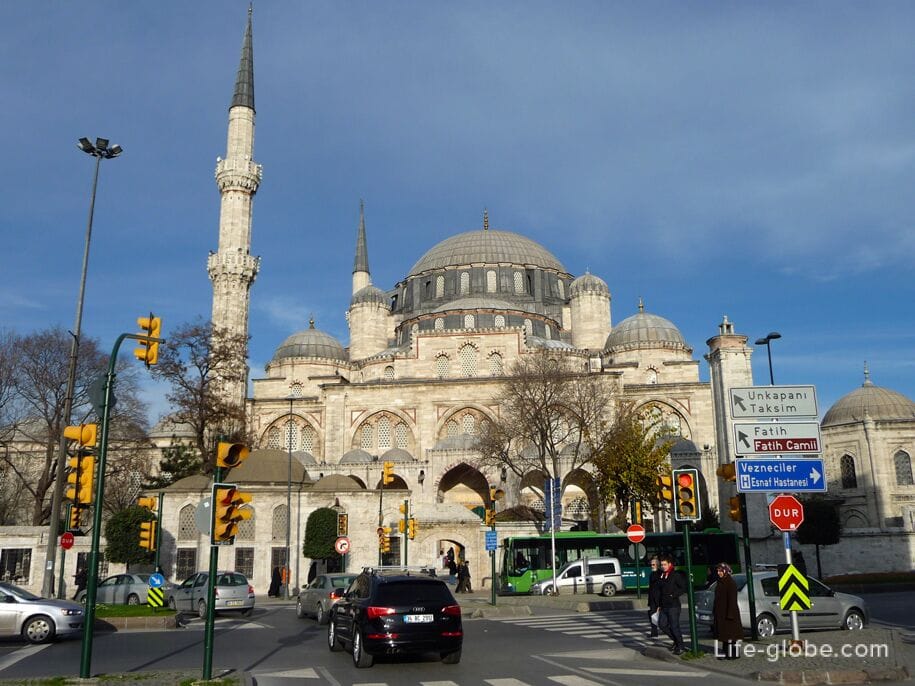

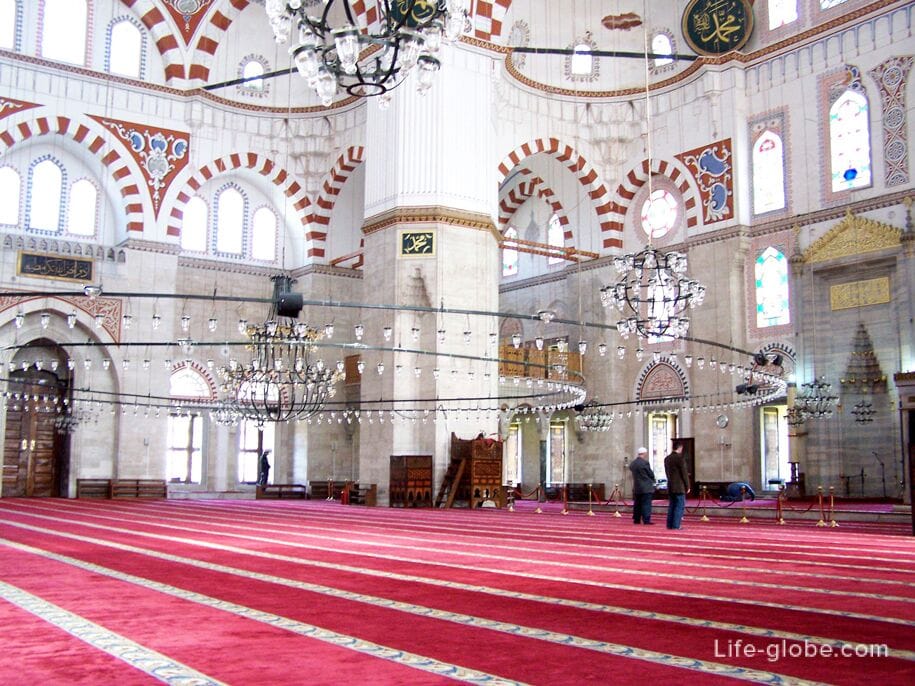
Pantokrator Monastery (Zeyrek Mosque)
The Pantokrator Monastery or Molla Zeyrek Mosque (Molla Zeyrek Camii) is the second largest monument of Byzantine architecture, preserved from Constantinople, after the Hagia Sophia Mosque.
The monastery is a complex that is known as the Monastery of Christ the Almighty (Christ Pantocrator, Pantokrator Manastırı), built since 1118 by the Byzantine Empress Irina Komnena.
During the history it was an Orthodox monastery, an imperial palace and a mosque.
Today, the complex is listed as a UNESCO World Heritage Site.
Near the mosque there is a panoramic cafe with a beautiful observation deck.
The complex is located on the European side of Istanbul, in the Fatih district, in the Zeyrek quarter, at the address: Zeyrek, Ibadethane Sk. No:2, 34083 Fatih/Istanbul, Turkey. Learn more about the Zeirek Mosque and the panoramic observation deck...
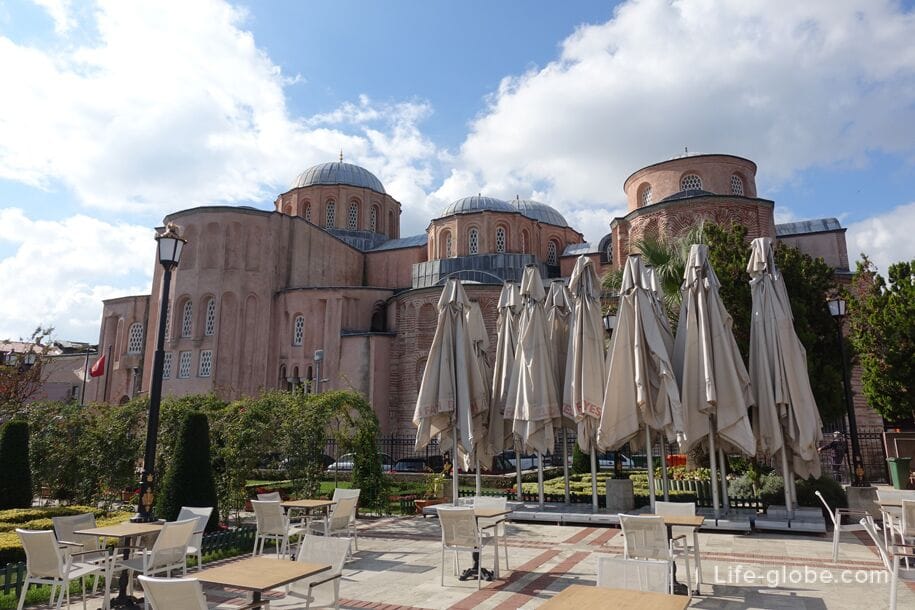
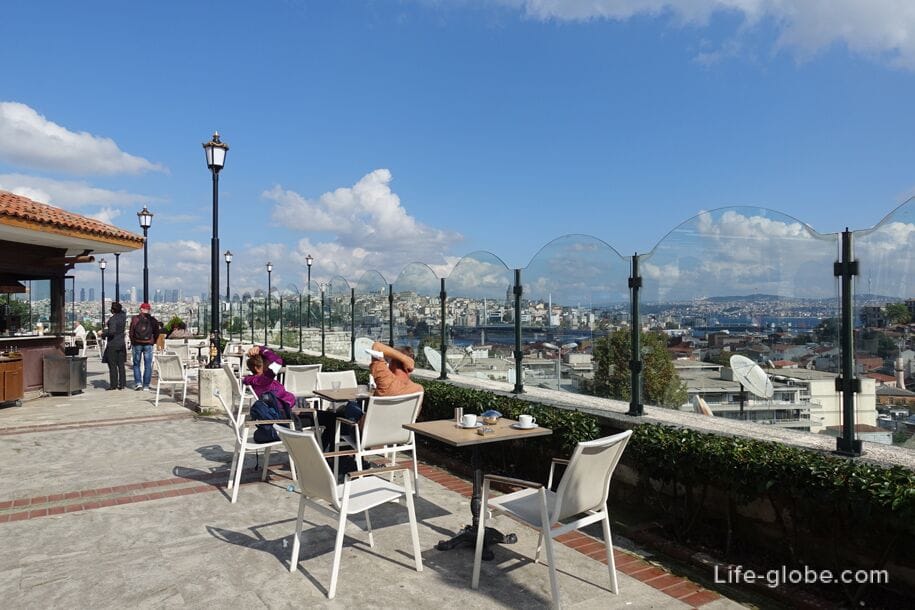
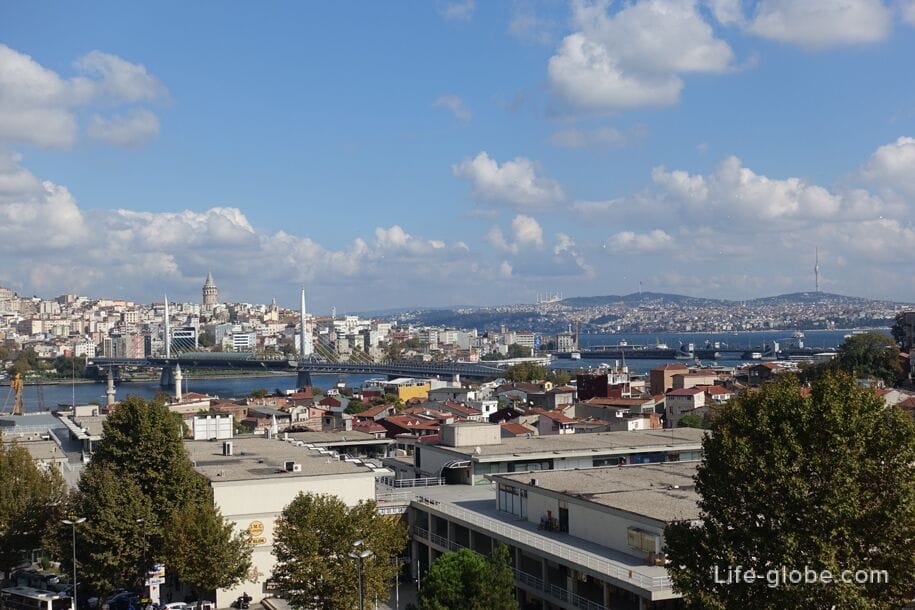
Fatih Mosque
Fatih Mosque (Fatih camii) was built as a complex on the hill of the city by order of Sultan Mehmed II the Conqueror in 1463-1470 on the site of the Byzantine Church of the Holy Apostles.
The mosque was destroyed by an earthquake in 1766 and rebuilt in 1771.
There is a madrasah at the mosque, and in the courtyard there is a cemetery where Mehmed II rests in the mausoleum, whose tomb is one of the important city shrines.
The mosque is located in the historical center of Istanbul.
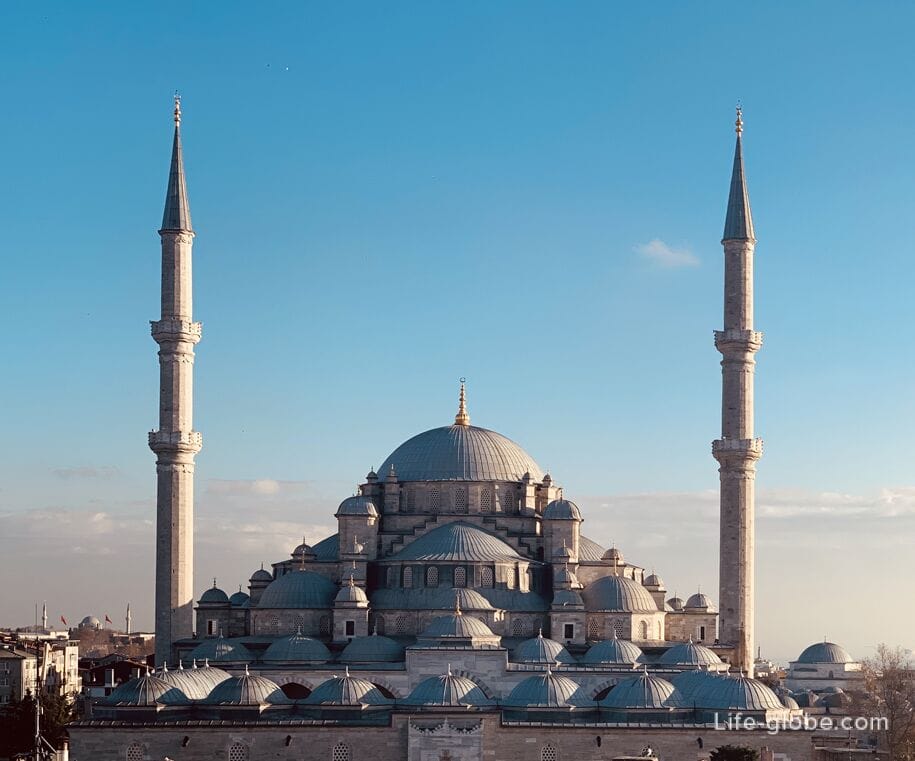

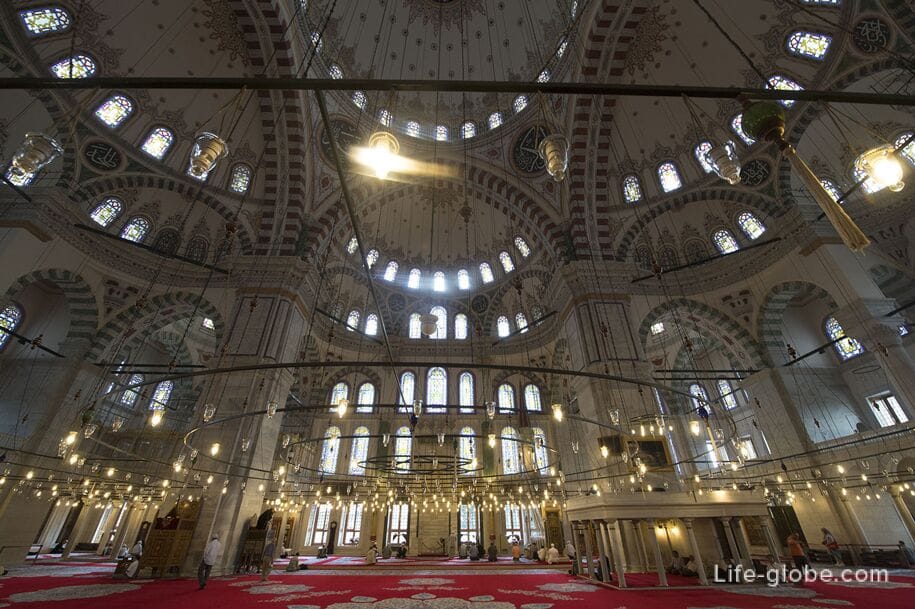
Selim Yavuz Mosque
The mosque of Selim Yavuz or Selim the Terrible (Yavuz Sultan Selim Camii) is an Ottoman imperial mosque of the 16th century with narrow minarets, a large dome, and a view of the Golden Horn Bay.
The mosque is also known as Selim I Mosque or Sultan Selim Yavuz Mosque, and is the second oldest surviving imperial mosque in Istanbul.
The mosque was completed in 1527-1528. The construction was commissioned by the Ottoman Sultan Suleiman the Magnificent in memory of his father Selim I, who died in 1520.
In the garden behind the mosque is the turbe of Sultan Selim I, built in 1523. The second octagonal turbe with a long inscription carved on the masonry outside contains the tombs of the four children of Suleiman the Magnificent and dates back to 1556. The third turbe belongs to Sultan Abdul-Majid I and was built shortly before his death in 1861.
The mosque's garden offers panoramic views of Istanbul and the Golden Horn Bay.
Address Mosques: Balat, Sultan Selim Cd. No.:18, 34087 Fatih/Istanbul, Turkey.
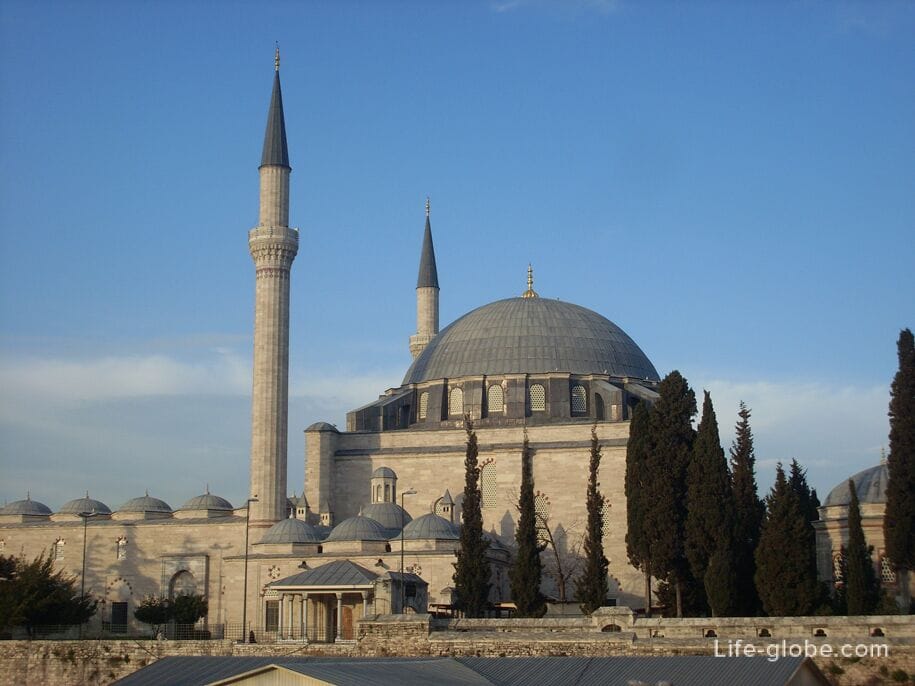

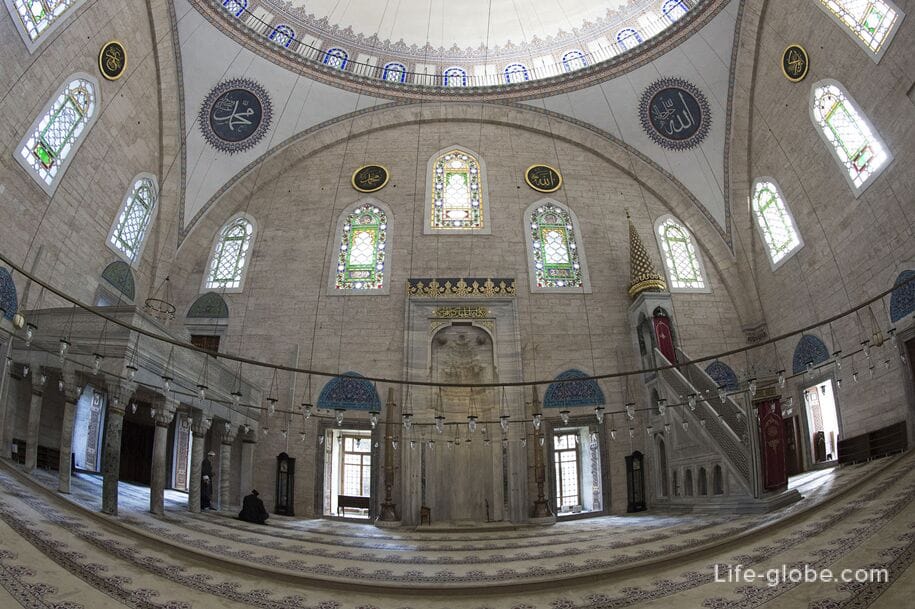
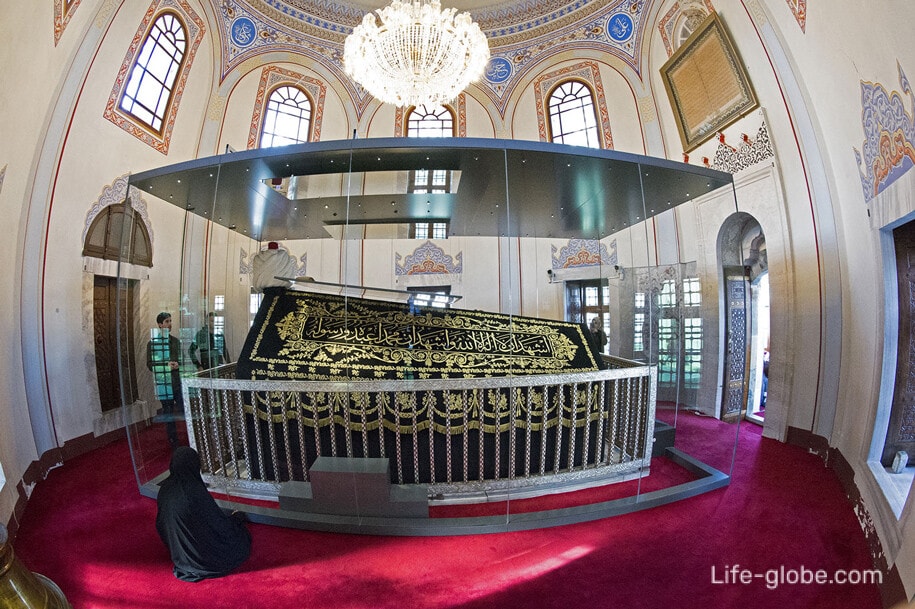
St. George's Cathedral
St. George's Cathedral (Aya Yorgi Kilisesi) is the main Orthodox cathedral of Istanbul, which, since about 1600, has been the seat of the Ecumenical Patriarchate of Constantinople.
This church, dedicated to the Christian martyr St. George, is the venue for numerous important services.
During its history, the church has been rebuilt many times.
It has a rich altar, an iconostasis, mosaics in the interior, relics of saints, ancient icons and part of the column "flagellation pillar" - the most important shrine-a pillar with the remains of the ring to which, according to legend, Jesus Christ was chained.
Church address: Yavuz Sultan Selim, Dr. Sadık Ahmet Cd. No:19, 34083 Fatih/Istanbul, Turkey.
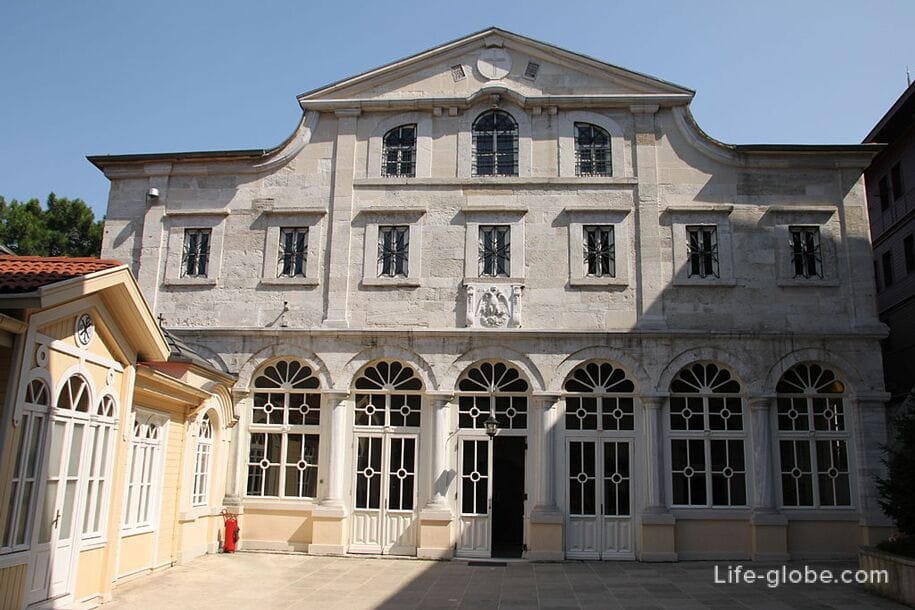
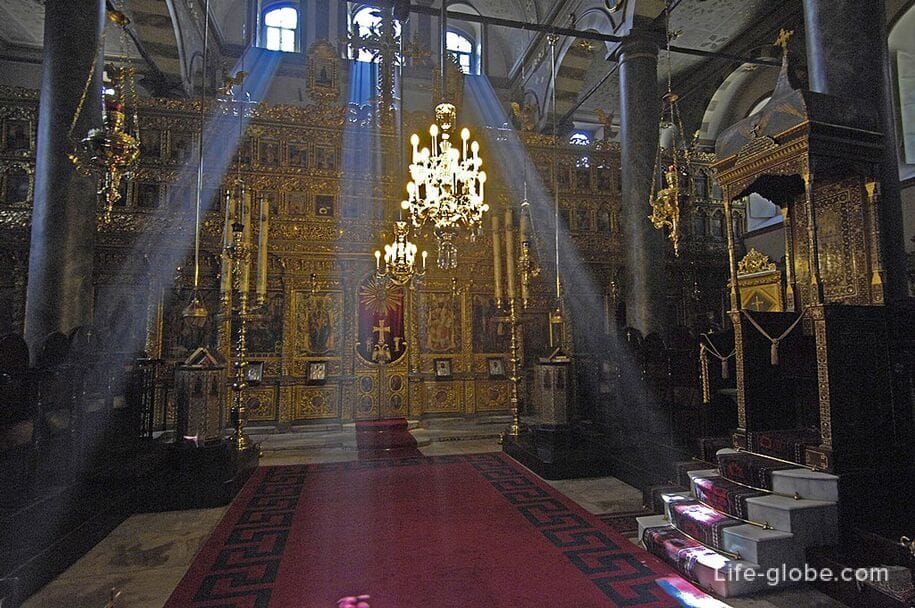
Church of Our Lady of Panagiotissa
The Church of Our Lady of Panagiotissa or the Church of Mary of Mongolia (Meryem Rum Ortodoks Kilisesi / Kanlı Kilise) is the only church of the Byzantine period in Istanbul that was not converted into a mosque in the Ottoman period and left for the worship of the Greeks.
The church was erected after the daughter of Mikhail, Maria Despina of Mongolia, who was widowed after the death of the Persian Ilkhan Abaki, returned to Constantinople (now Istanbul) in 1281.
Under the Sultans Selim I and Ahmed II, they tried to turn the church into a mosque, but this plan was not implemented and the Church of Mary of Mongolia remains the parish church of the Greek community of the Fatih district today.
The church is open for visits on request.
Church address: Balat, Tevkii Cafer Mektebi Sk. No:1, 34087 Fatih/Istanbul, Turkey.
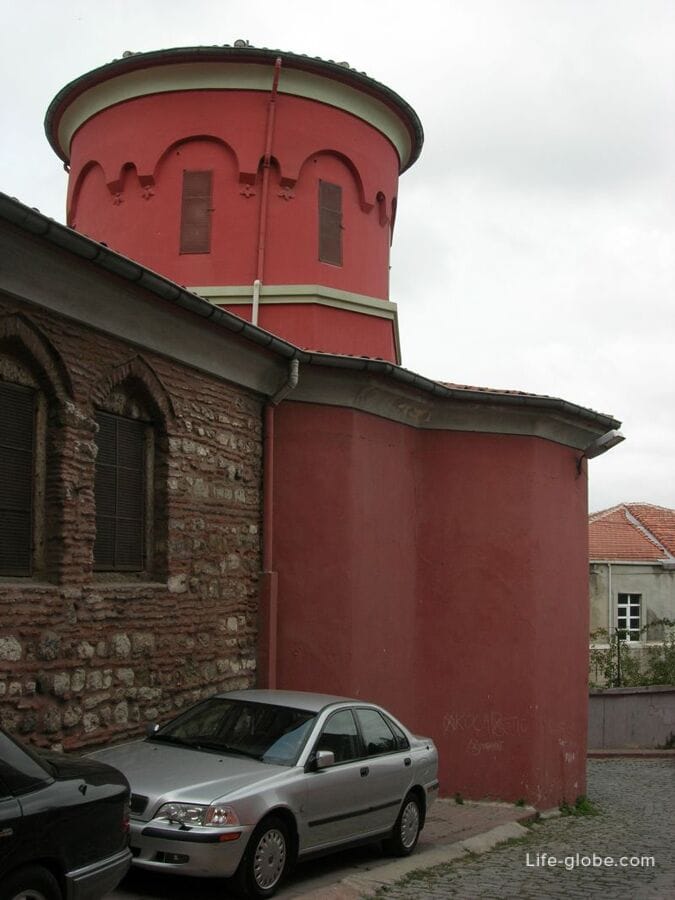
St. Stephen 's Church
The Bulgarian Church of St. Stephen (St. Stephen's Bulgarian Orthodox Church / Sveti Stefan Kilisesi, Bulgarian Church) is an elegant Orthodox church in honor of the First Martyr Stephen, belonging to the Bulgarian community of Istanbul.
The church is known for being made of prefabricated cast-iron elements in the neo-Byzantine style. It is one of the few remaining temples in the world made of this material.
The richly ornamented church is a three-domed cruciform basilica, the altar of which faces the Golden Horn, and a 40-meter belfry rises above the narthex, six bells of which were cast in Yaroslavl.
Church address: Balat, 34087 Fatih/Fatih/Istanbul, Turkey.
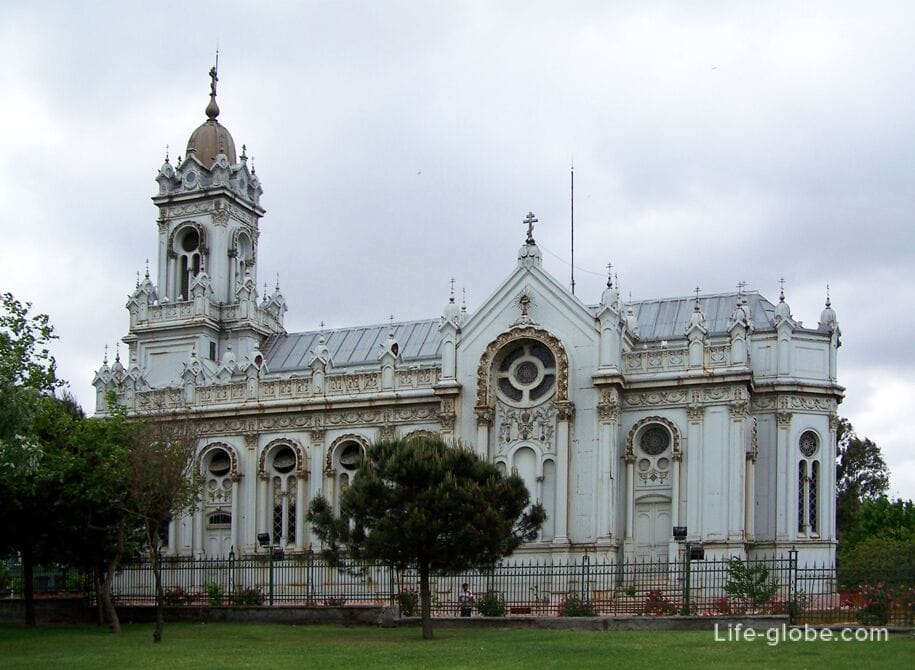
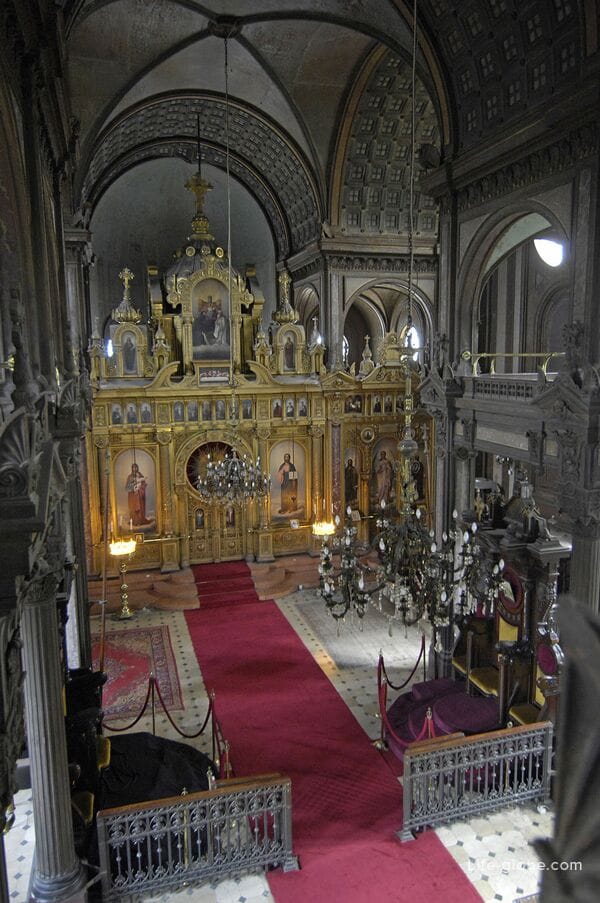
Church of Our Lady of Pammakarista (Fethiye Mosque)
The Church of the Theotokos of Pammakarista (Fethiye Camii, Mosque of Conquest) is a former Greek church of the Pammakaristos Monastery, turned into the Fethiye Mosque in 1591, with exquisite mosaics and late Byzantine architecture.
Most scholars believe that the church was built between the 11th and 12th centuries, while others attribute the original building to the 8th century.
The building serves as one of the most important examples of Palaiologan architecture of Constantinople and the last pre-Ottoman architectural monument. The shrine also has the largest number of Byzantine mosaics in Istanbul after Hagia Sophia and the Choir Church.
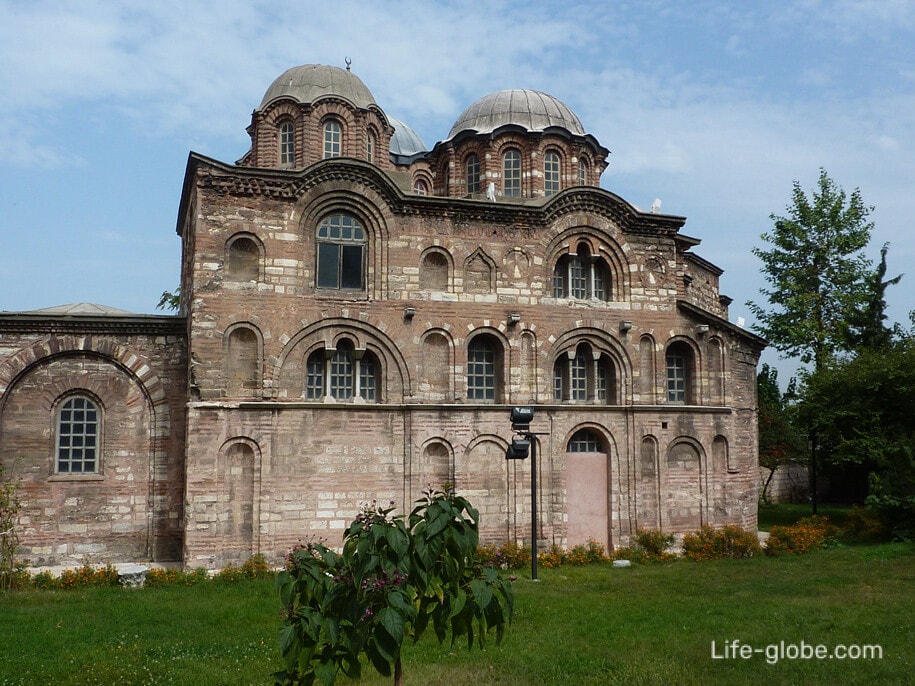
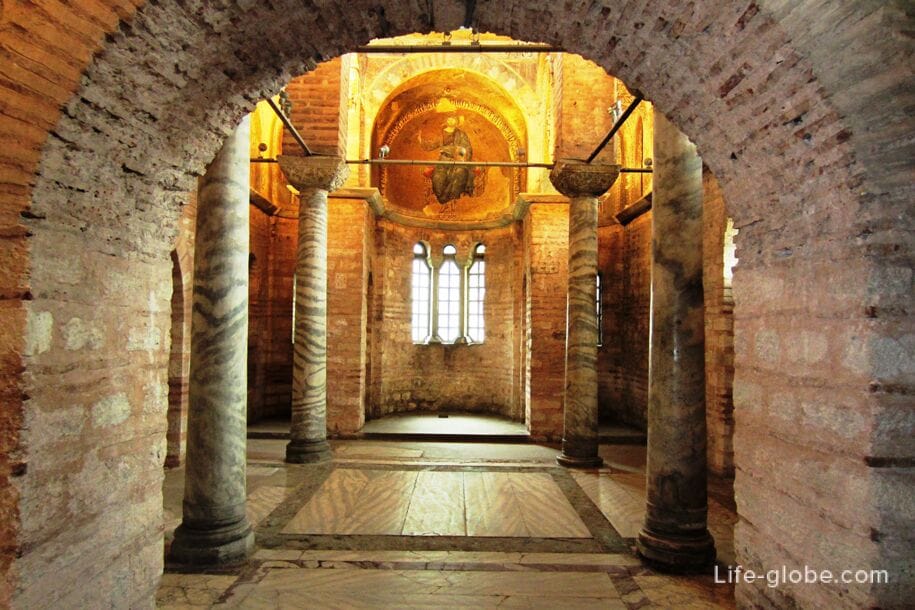
Khora Monastery (Kariye Mosque)
The Kariye Mosque or Monastery of Chora, also the Church of the Holy Savior in Chora (Kariye Camii) is a medieval Greek Orthodox church used today as a mosque.
The Church of the Savior in the Choir is built in the style of Byzantine architecture. In the 16th century, during the Ottoman Empire, the Christian church was turned into a mosque. It became a museum in 1945 and was turned into a mosque again in 2020.
The interior of the building is covered with some of the oldest and best preserved Byzantine Christian mosaics and frescoes. In addition to mosaics, the mosque also has colorful and patterned marble decorations.
After the building was converted from a church into a mosque, Christian symbols: inscriptions, frescoes and mosaics were covered with fine paint and lime whitewash, without destroying the building, so it has survived to this day.
Mosque address: Dervişali, Kariye Cami Sk. No:18, 34087 Fatih/Istanbul, Turkey.
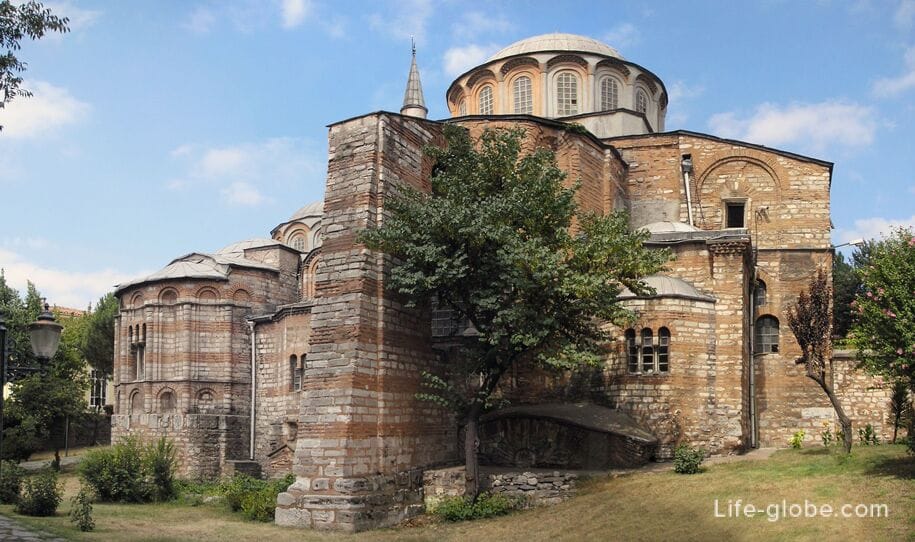

Mihrimah Sultan Mosque (Edirnekapi)
Mihrimah Sultan Mosque (Mihrimah Sultan Camii) is an Ottoman mosque of the 16th century, located on top of one of the highest hills of Istanbul (the Sixth Hill) and is a vivid symbol of the medieval architecture of the capital of the Ottoman Empire.
The mosque was built from 1562 to 1565 for the beloved daughter of Sultan Suleiman I the Magnificent - Mihrimah Sultan.
The mosque was built as a complex, which, in addition to the central building, also included: a madrasah, a hammam, a turbe and a number of shops for rent. There is a fountain for ablution in the courtyard.
A carved marble minbar attracts attention in the interior of the mosque. The doors and window shutters are made of wood inlaid with mother-of-pearl and ivory.
Mosque address: Karagümrük, 34091 Fatih/Istanbul, Turkey.
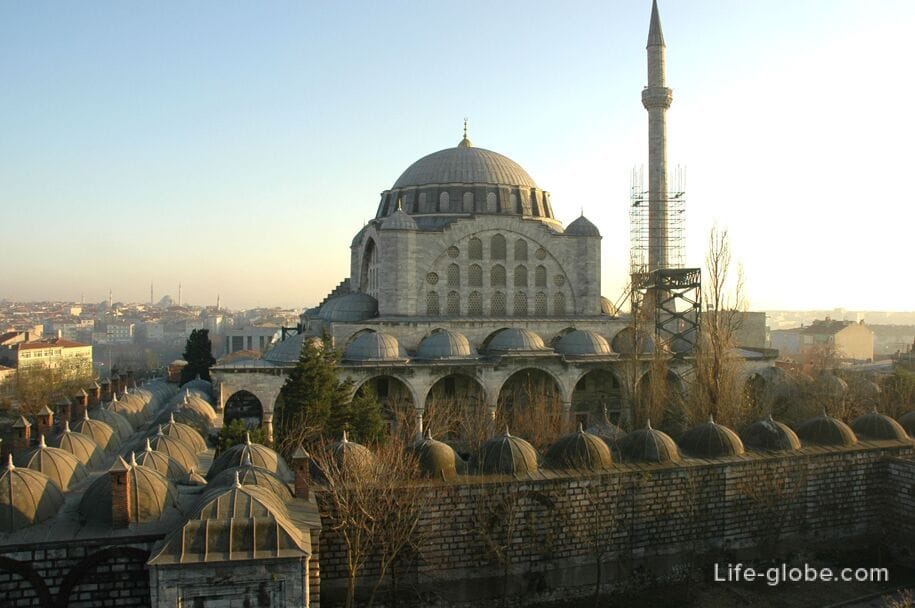

Laleli Mosque
Laleli Mosque (Laleli camii) is an Ottoman imperial mosque of the 18th century in the Baroque style.
The mosque was built in the Ottoman Baroque style in 1760-1763 by decree of Sultan Mustafa III.
Laleli is also called the "tulip mosque", because of the shape of the dome and the word "Laleli". But most likely, the mosque was named after Saint Laleli Baba, whose grave was located next to the mosque.
The mosque complex consisted of a mosque, an imaret, a madrasah, a fountain and a mausoleum. Some of the buildings ceased to exist or were reconstructed during the city improvement works in the 20th century.
The mosque itself consists of a square prayer hall and a rectangular courtyard surrounded by a gallery with a fountain for ritual ablutions in the center.
The mausoleum of the mosque houses the turbe of Mustafa III and his son Selim III.
Mosque address: Kemal Paşa, Ordu Cd., 34134 Fatih/Istanbul, Turkey.
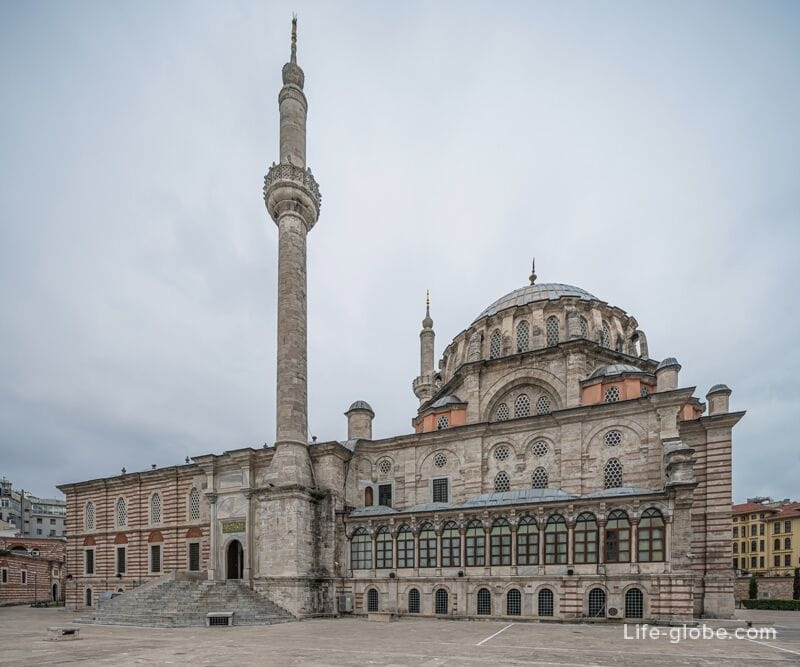
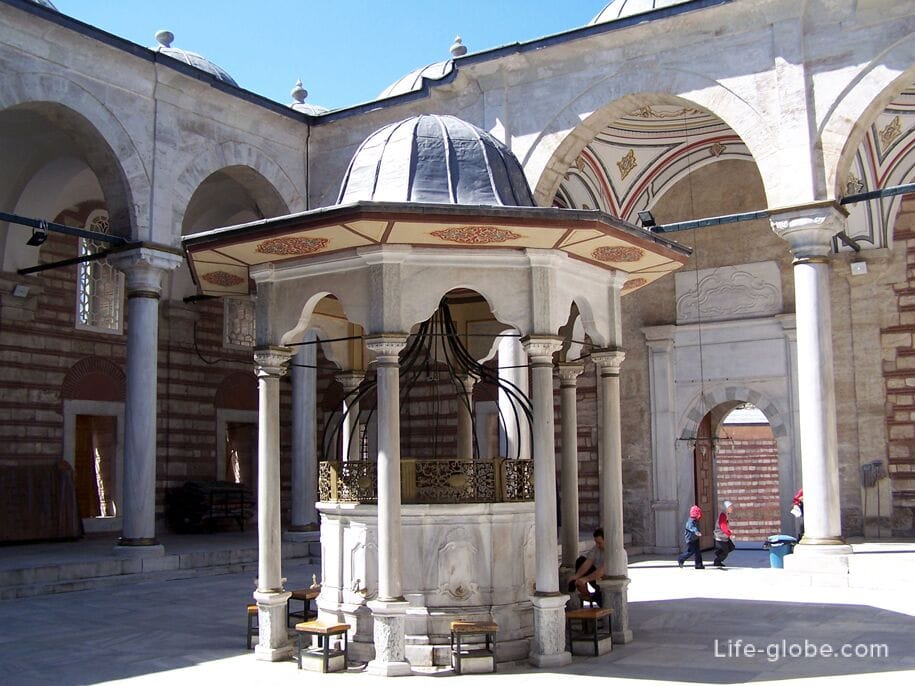
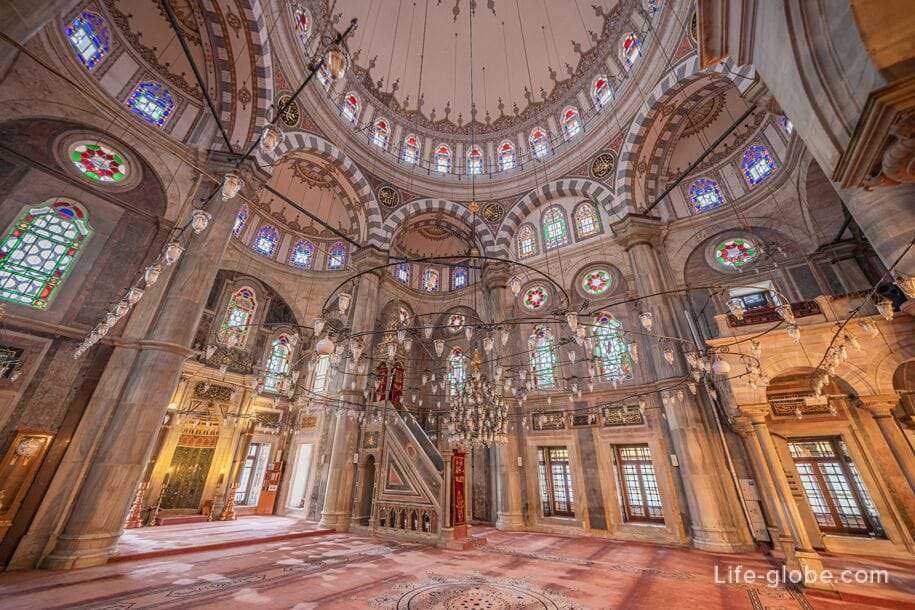
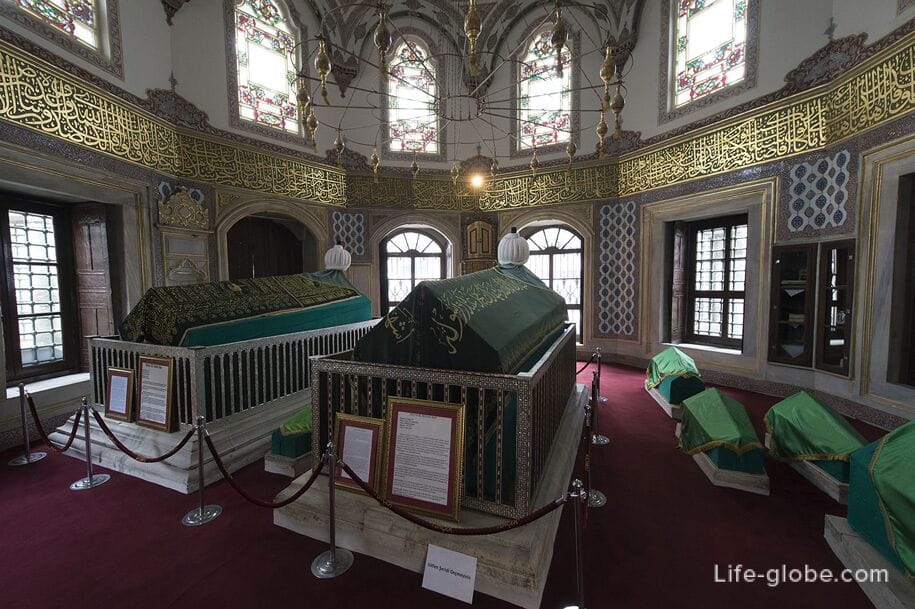
Pertevnial Valide Sultan Mosque
The Pertevniyal Valide Sultan Mosque, also known as the Aksaray Valide Mosque (Pertevniyal Valide Sultan Camii, Aksaray Valide Sultan Camii), is perhaps the most unusual mosque in Istanbul outwardly.
This Ottoman Imperial mosque was built one of the last in Istanbul during the Ottoman Empire.
The mosque was built in 1869-1871 for Pertevnial Sultan, the wife of Sultan Mahmud II and the mother of Sultan Abdul Aziz.
The mosque was designed by Sarkis Balyan as a new, at that time, architectural masterpiece.
The building is an example of Turkish Rococo with an admixture of classical Ottoman, Moorish, Turkish, Gothic, Renaissance and Empire styles. The structure of the mosque also seems to be based on Indian, North African and Andalusian architecture. The overall design of the mosque can be noted as a projection of the nascent power of the Ottoman women of that time.
The mosque has two minarets and a small (in diameter), but high dome.
The mosque consists of several different buildings. There are buildings that surround the central mosque and create a complex. These buildings consist of a tomb, a sabil, a chapel, a library and a madrasah.
The interior of the mosque, as well as its facades, is elaborately decorated and stylized with bold oriental motifs. There are classic Ottoman details on the walls: blind niches, flourishes, arabesques and floral arrangements in the Chinese style. The interior also has a simple marble mihrab and a minbar.
The grave of Sultana Pertevnial is located in the central mosque.
Mosque address: Iskenderpaşa, Atatürk Blv. No:3, 34080 Fatih/Istanbul, Turkey.
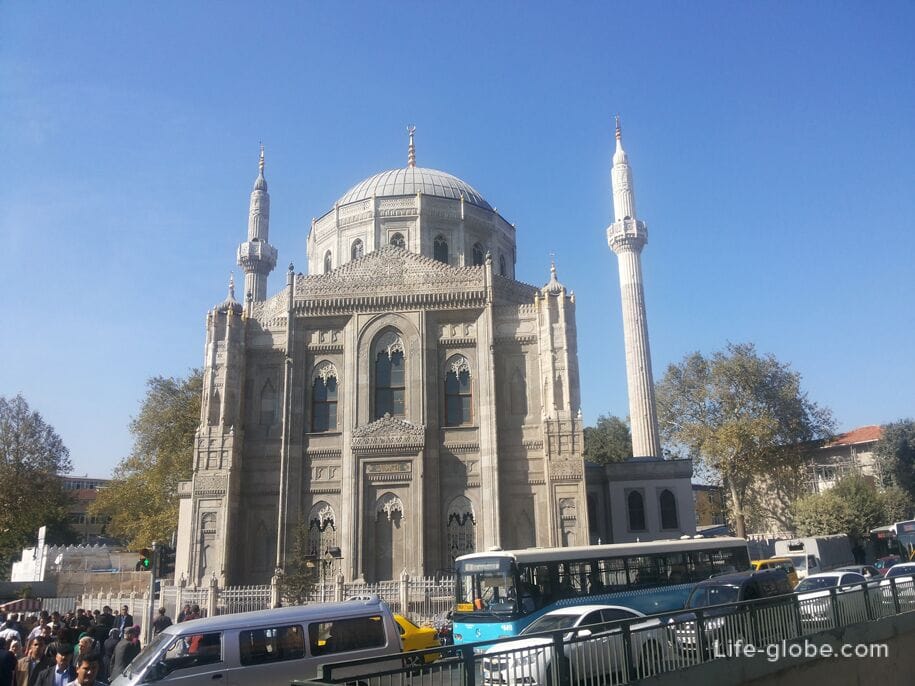
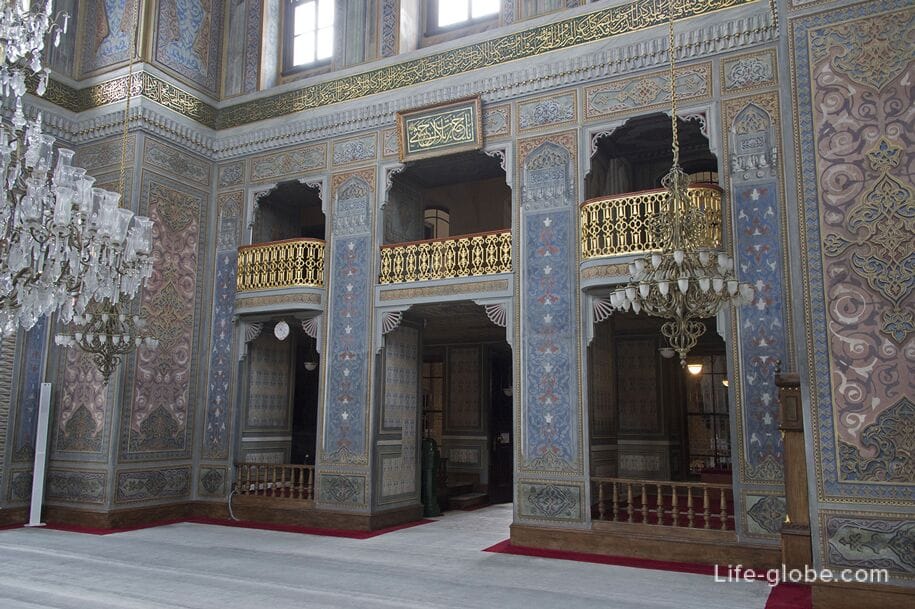
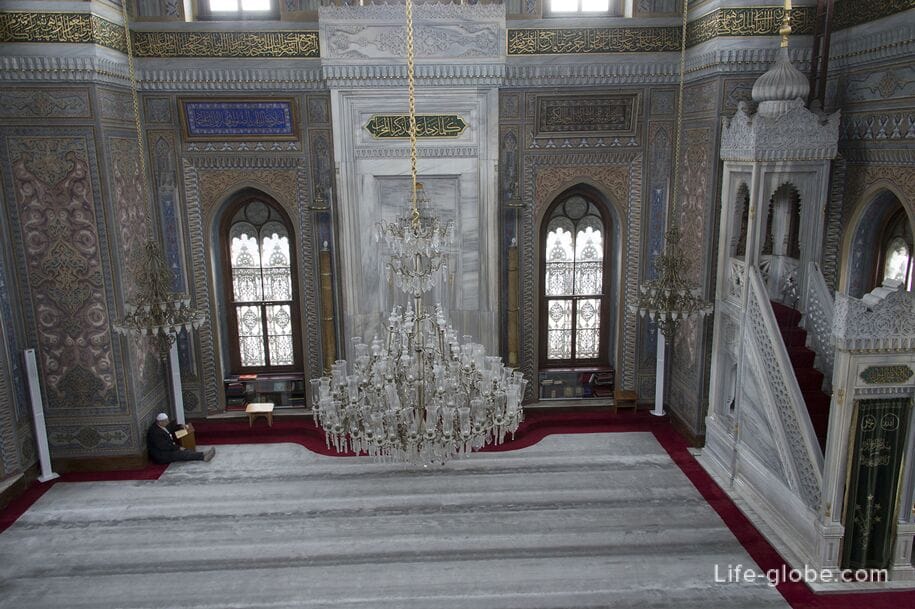
All of the above mosques, churches and cathedrals are located in the historical center of Istanbul - in the Fatih district.
Eyup Sultan Mosque
The Eyup Sultan Mosque (Eyüp Sultan Camii) is a 15th-century mosque, rebuilt in 1800, and has features of the Baroque style.
The mosque was a traditional place for the coronation ceremony of the Ottoman sultans, where the new sultan was girded with the sword of Osman.
Sultan Eyup Mosque is now one of the oldest and most sacred mosques in Turkey. It is the fourth most important Muslim shrine in the world after Mecca, Medina and Jerusalem.
The mosque complex includes a mausoleum marking the place where Abu Ayyub al-Ansari, the standard-bearer and friend of the Islamic Prophet Muhammad, is said to have been buried.
Eyup Sultan is believed to have died during the first Arab siege of Constantinople in the 670s. His mausoleum-grave is very revered by Muslims and is located on the territory of this mosque.
The mosque is located near the lower station of the Eyüp-Piyer Loti Teleferik Hatt (TF2) gondola cable car, which lifts guests to the observation deck of Pierre Loti Hill, which offers stunning panoramic views of Istanbul. You can combine a visit to two attractions. More about the Pierre Loti observation and cable car...
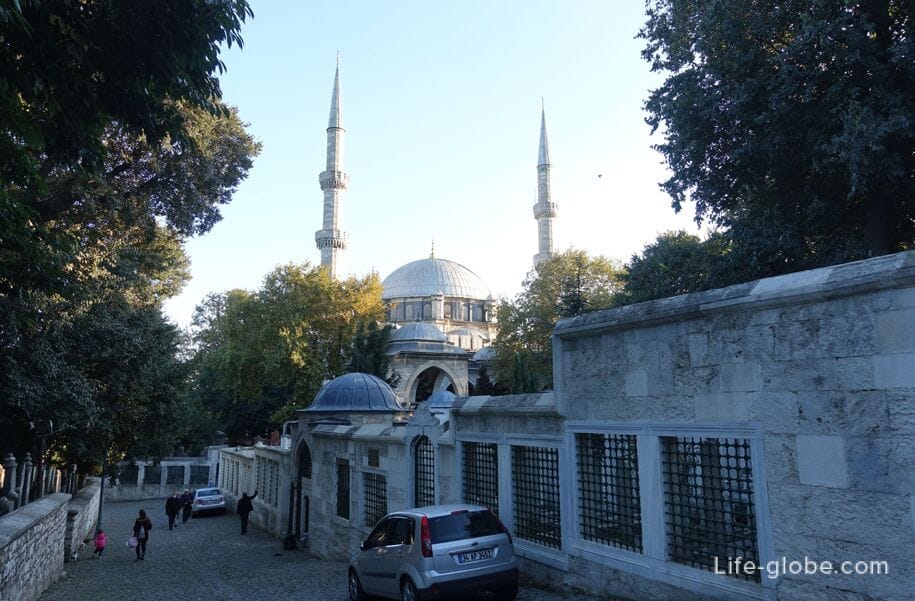
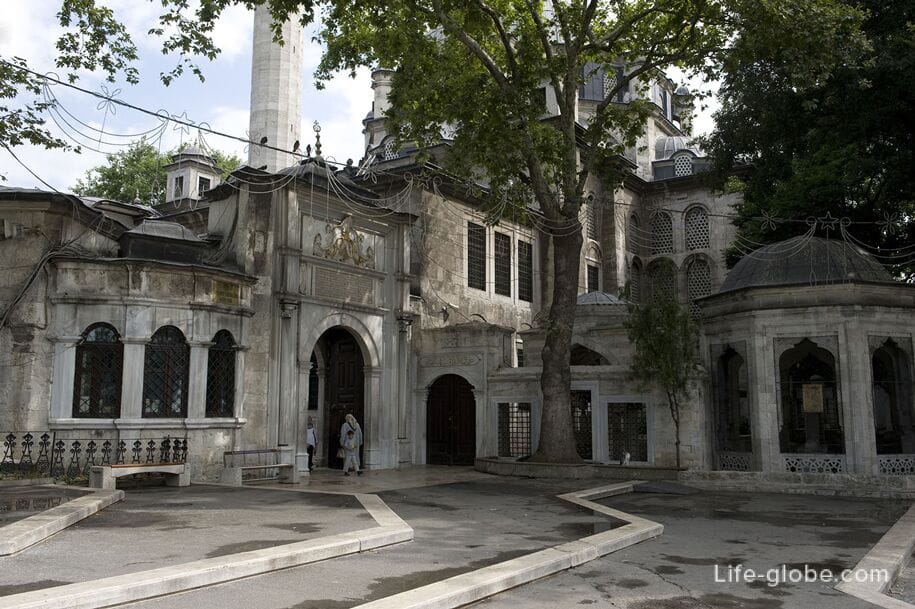
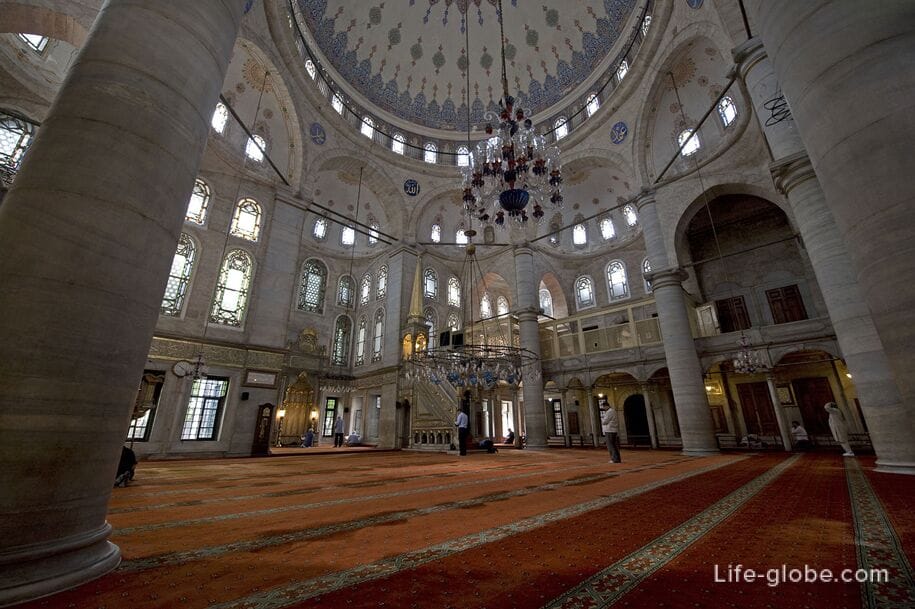
Photo of the Pierre Loti viewing room
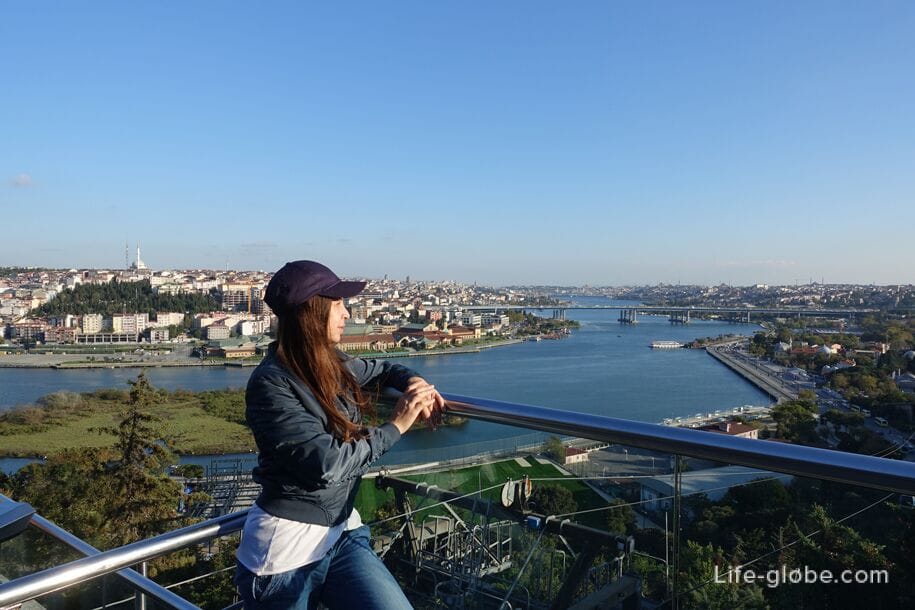
Shrines along Istiklal Street
Istiklal (Istiklal Caddesi) is the most famous pedestrian shopping street in Istanbul, which attracts many tourists and locals.
A historic red retro tram of the T2 line runs along the street, connecting Taksim Square and Tunel, where the Beyoğlu underground funicular station is located.
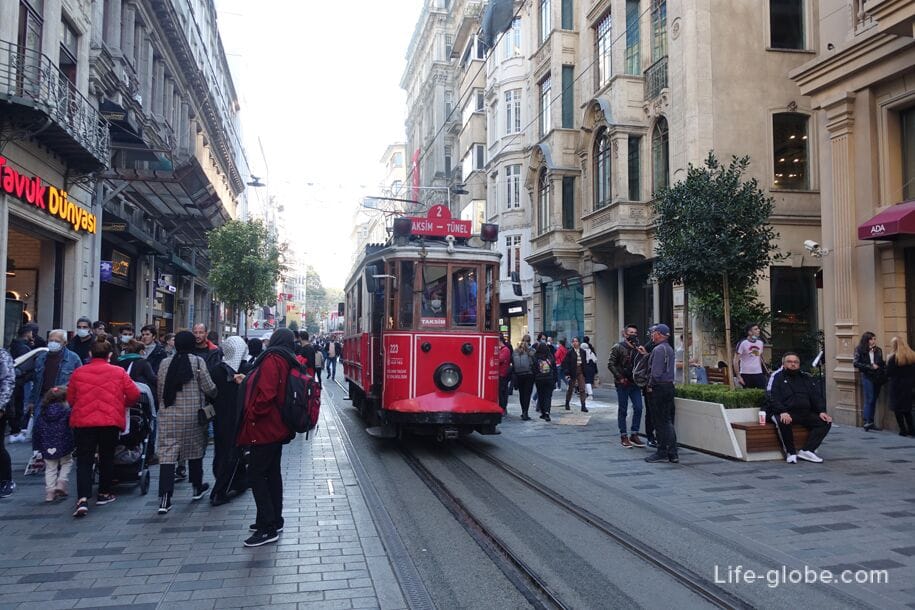
Along the street there are: buildings, including historical ones; shops, boutiques and souvenir shops; cafes, bars and restaurants; hotels and apartments 
- The Church of St. Maria Draperis (Santa Maria Draperis Kilisesi) is a Roman Catholic church built in 1584 and is one of the oldest Roman Catholic parishes in Istanbul;
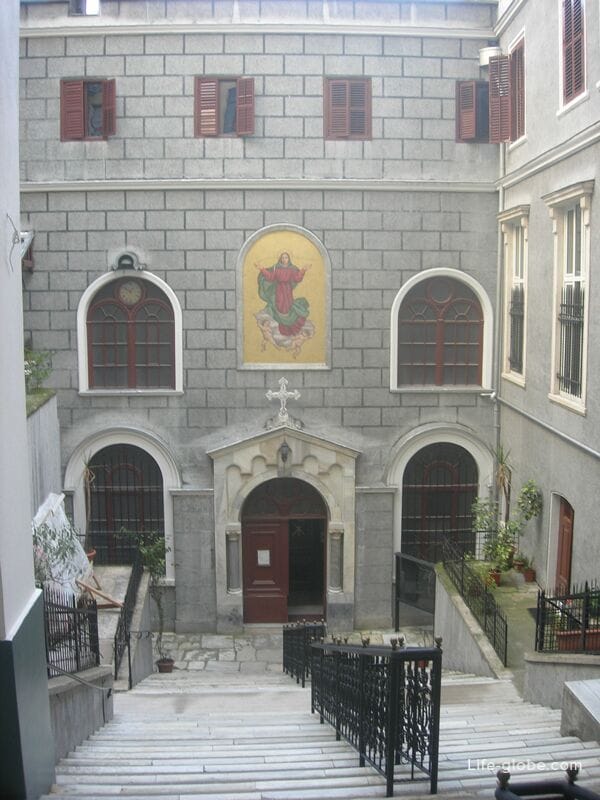
- St. Anthony of Padua Cathedral (Sent Antuan Kilisesi) is a church in the Venetian Neo-Gothic style, built by the Italian architect Giulio Mongeri and opened in 1912;
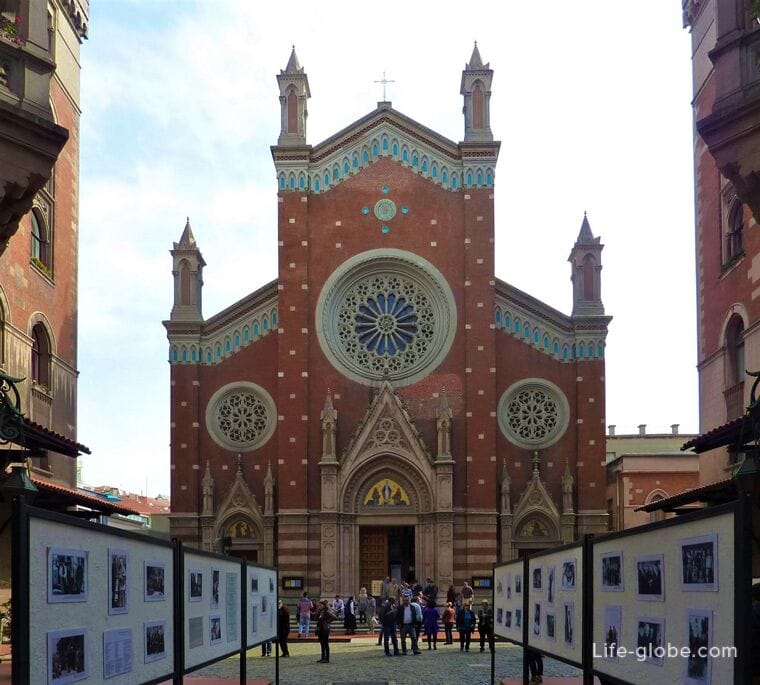
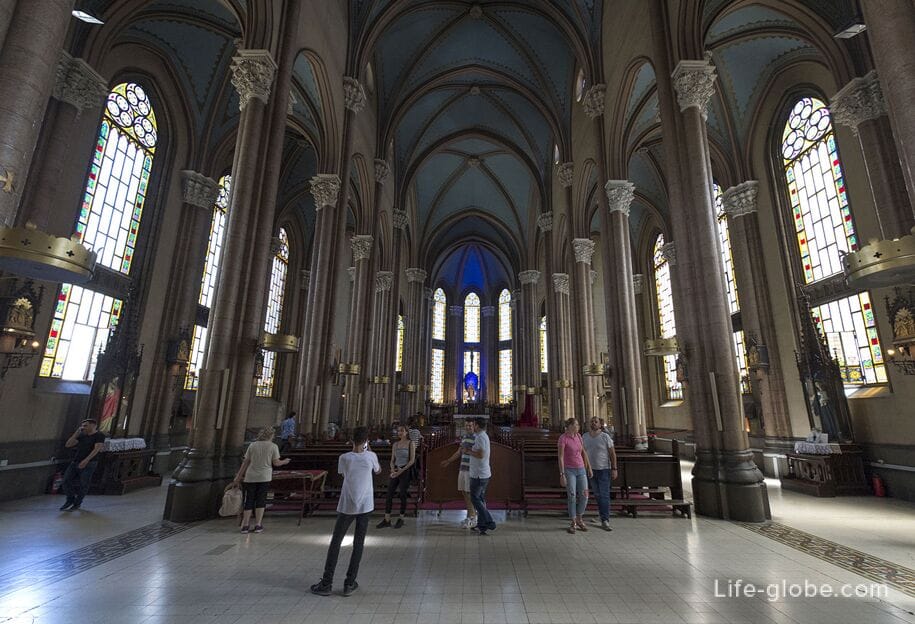
- the small mosque of Beyoglu Huseyin Agha (Hüseyin Ağa Camii). More about Istiklal Street...
Taksim Mosque
The Taksim Mosque (Taksim Camii) was erected in 2017-2021, although the plan of the mosque has been developed since 1952.
The mosque adorns one of the main squares of Istanbul - Taksim Square (Taksim Meydanı). More about Taksim Square...

Holy Trinity Church
The Church of the Holy Trinity (Aya Triada Rum Ortodoks Kilisesi) is a Greek Orthodox church opened in 1880.
The temple stands out with stained glass windows, gilded domes and elegant paintings on the ceiling.
The church is located near Taksim Square, at the address: Katip Çelebi Mah., 34433 Beyoğlu/Beyoglu/Istanbul, Turkey.
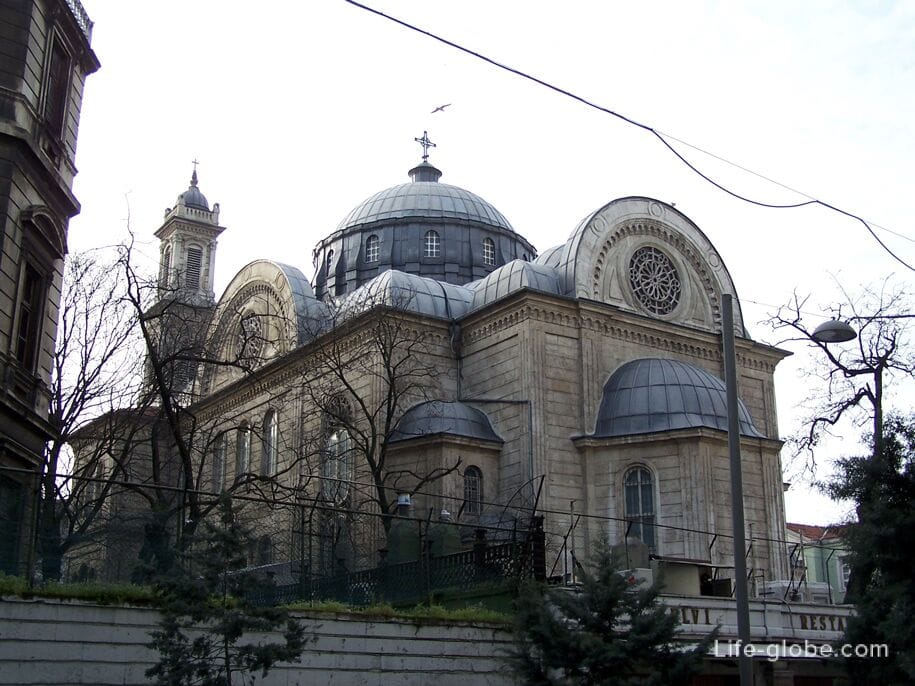
Nusretiye Mosque
The Nusretiye Mosque (Nusretiye Camii) is an ornate mosque built in 1823-1826 by Sultan Mahmud II.
While the architecture of the mosque has absorbed Islamic elements, it retains the Baroque style, which makes this mosque unique for the city.
Mosque address: Kılıçali Paşa, Meclis-i Mebusan Cd., 34425 Beyoğlu/Istanbul, Turkey.
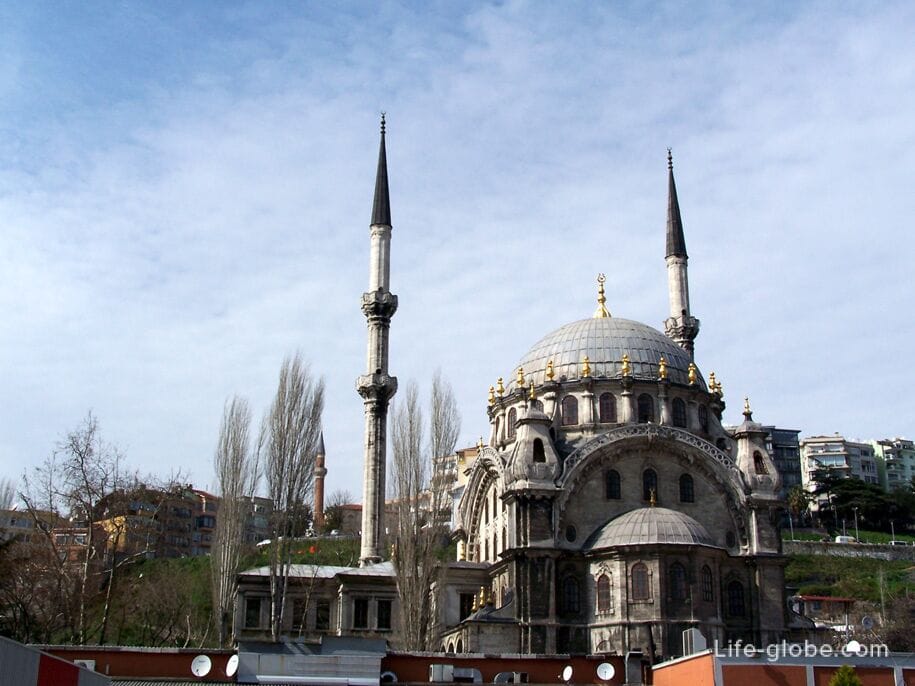
Jihangir Mosque
The Jihangir Mosque (Cihangir Camii) was built in 1559 by the famous architect Sinan, by order of Sultan Suleiman I the Magnificent in memory of his youngest son Shehzad Jihangir.
During its history, the mosque was destroyed several times as a result of fires and earthquakes, and after that it was always restored. For the last time, after the destruction in a fire, the mosque was rebuilt in 1874 in the neoclassical style by Sarkis Balyan on the orders of Abdul-Aziz. The minaret, located to the east of the mosque itself, was built in 1928.
Mosque address: Pürtelaş Hasan Efendi, Münir Özkul Sok. No:22, 34427 Beyoğlu/Istanbul, Turkey
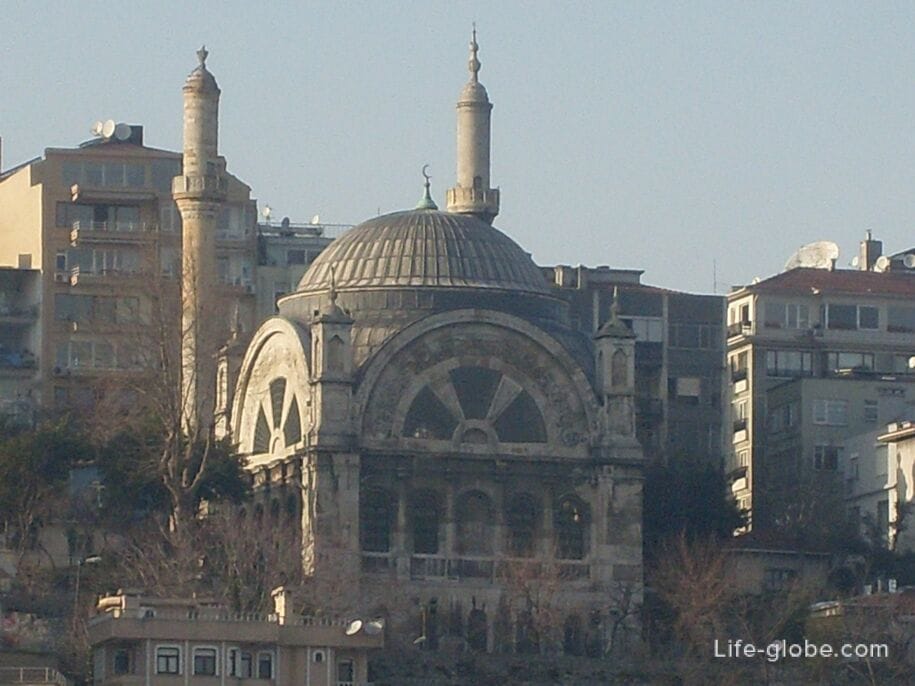
Dolmabahce Mosque
Dolmabahce Mosque (Dolmabahce Camii) was built according to the project of Garabet Balyan in 1853-1855. The mosque was commissioned by the Queen mother of Sultan Abdul-Majid I - Bezmlialem-Sultan.
The influence of Baroque and Rococo styles is noticeable in the interior of the mosque.
This elegant Ottoman-style mosque with two minarets is located near one of the best Ottoman palaces in Istanbul - Dolmabahce Palace (Dolmabahçe Sarayı). More about Dolmabahce Palace...
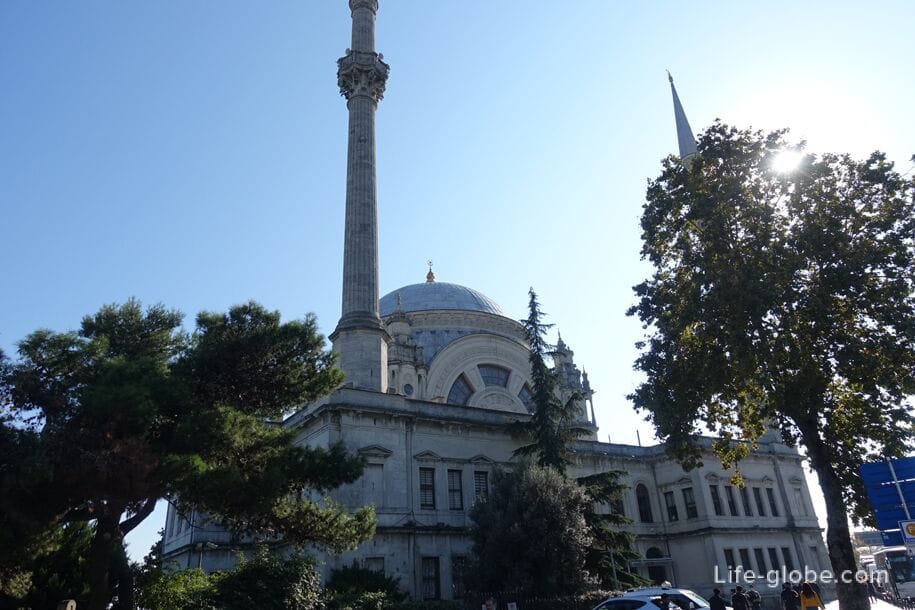
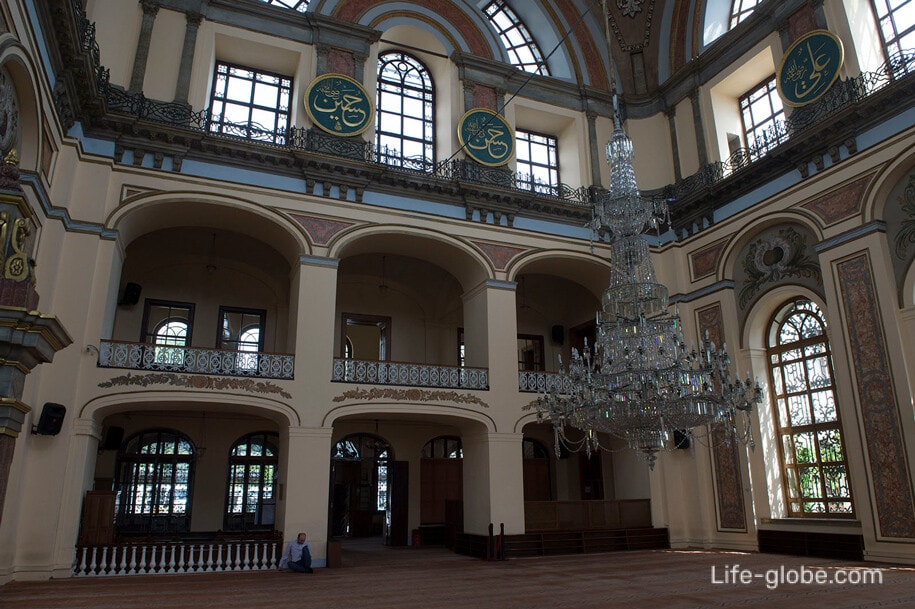
Yildiz Hamidiye Mosque
Yıldız Hamidiye Mosque (Yıldız Hamidiye camii) is an Ottoman imperial mosque built in 1884-1886 by order of the Ottoman Sultan Abdul Hamid II.
The architecture of the mosque is a combination of Neo-Gothic and classical Ottoman styles. The mosque has one minaret.
The mosque is located near a large historical palace and park complex of the 19th century - Yildiz (Yıldız). More about Yildiz Palace and Park...
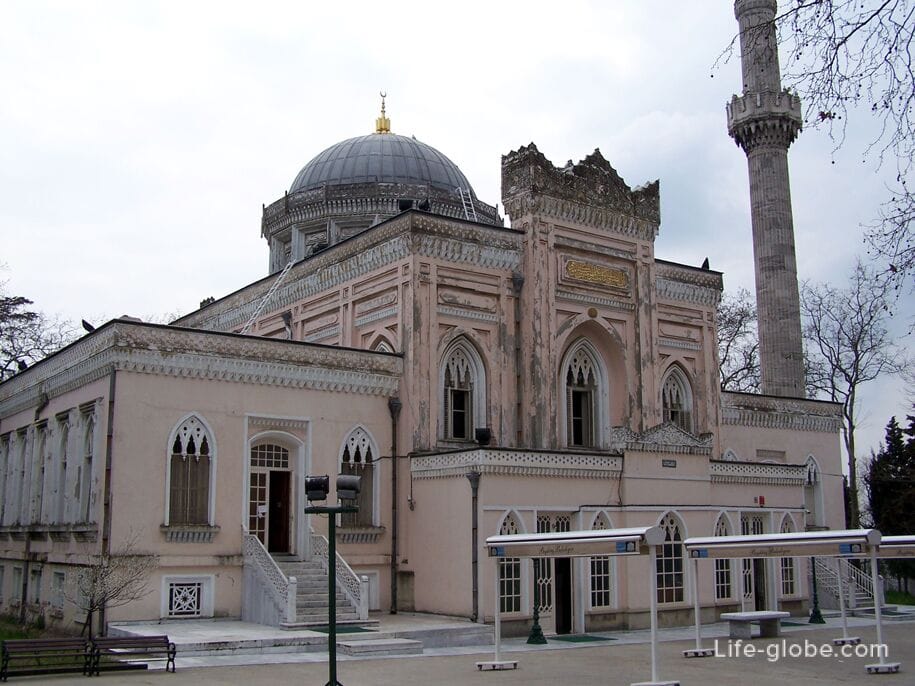
Ortakoy Mosque
The Ortakoy camii Mosque, also known as the Grand Mosque of the Medjidiye (Büyük Mecidiye Camii), is a very popular mosque in Istanbul and primarily due to the fact that it looks like a small sultan's palace and is located near the waters of the Bosphorus Strait, which makes the mosque one of the most photographed attractions in the city.
The mosque was built in the Ottoman Baroque style in 1853-1854 by decree of Sultan Abdul-Majid I.
The mosque has two minarets.
Mosque address: Mecidiye, Mecidiye Köprüsü Sk. No:1 D:1, 34347 Beşiktaş/Istanbul, Turkey.
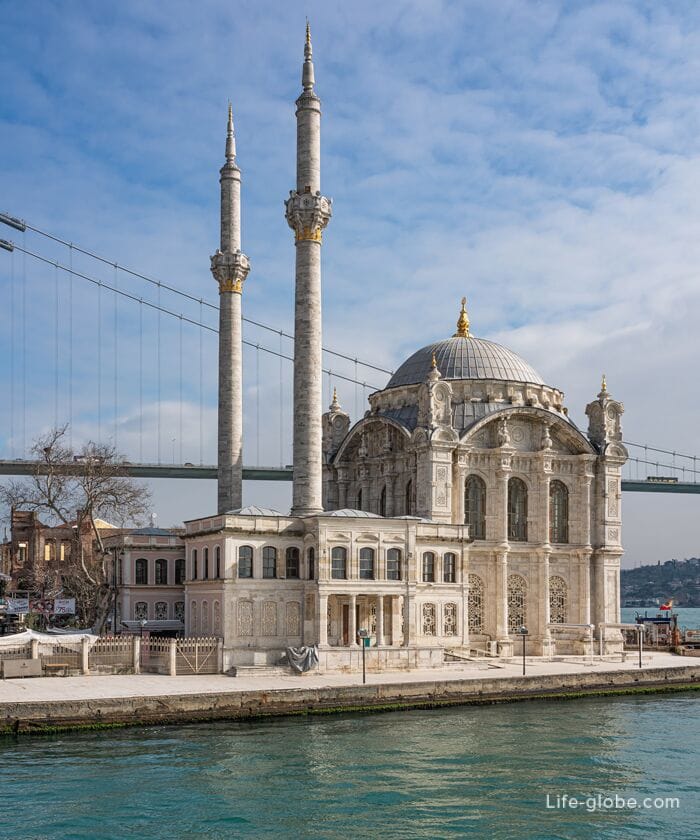
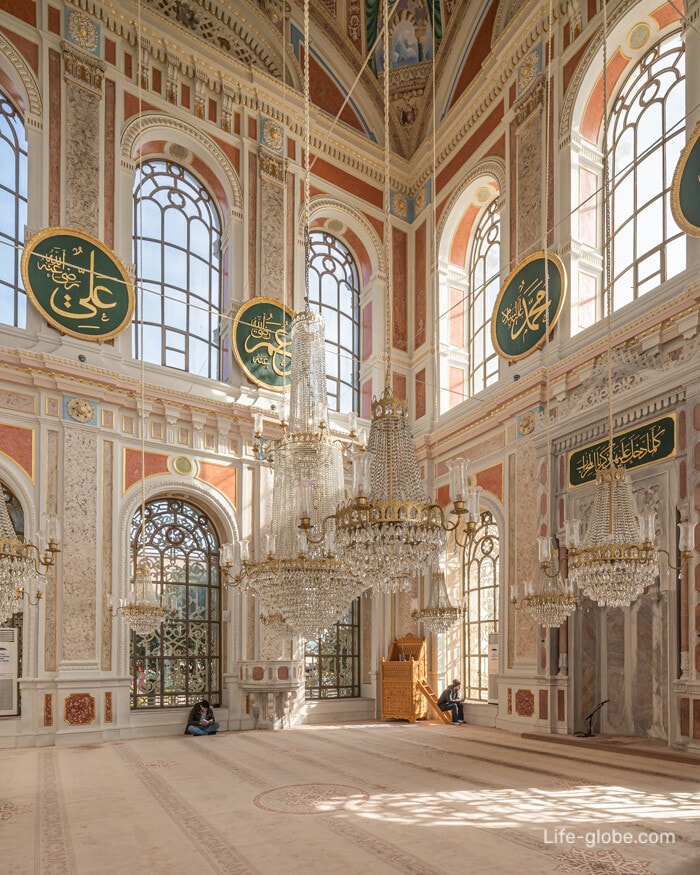
Beylerbey Mosque
Beylerbey Mosque or Hamid-i-Evvel Mosque (Beylerbeyi camii, Hamid-i Evvel Camii) is an 18th-century sultan mosque, which is one of the most impressive mosques on the Asian side of Istanbul and is considered one of the most beautiful manor mosques in Istanbul.
The mosque building was built by Sultan Abdulhamid I in memory of his mother Rabia Sermi Sultan, in the place where part of the former Beylerbeyi Palace was located. The mosque opened its doors for worship on August 15, 1778.
Since the mosque is located near the waters of the Bosphorus and suffered from constant water flows, it was changed during the reign of Mahmut II.
The mosque is located near the former Sultan's Palace of Beylerbeyi (Beylerbeyi Sarayı), at the address: Beylerbeyi, 34676 Üsküdar/Istanbul, Turkey. More about the Beylerbeyi Palace...
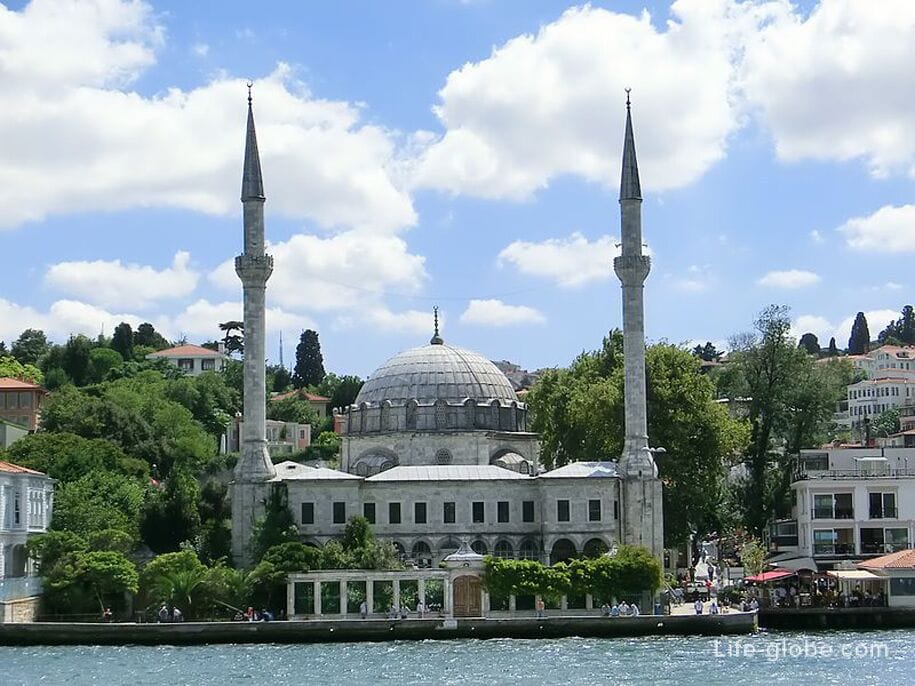
Chamlyja Mosque
The Chalmidja Mosque (Büyük Çamlıca camii) is the largest mosque in Istanbul, which is new, its construction was completed in 2019.
This mosque has six minarets, which represent the six symbols of the Islamic faith.
The Chamlija Mosque has a museum, underground parking, an art gallery, a library, a conference hall and a kindergarten.
Among the guests of the city, the Chalmidzha Mosque is also attractive because it is located on the Large Hill of Chamlidzha (Çamlıca Tepesi), where beautiful panoramic views of Istanbul open from the terrace near the mosque. And in a public park on a hill with trees, flower beds and fountains there are historical tea houses, cafes and a restaurant.
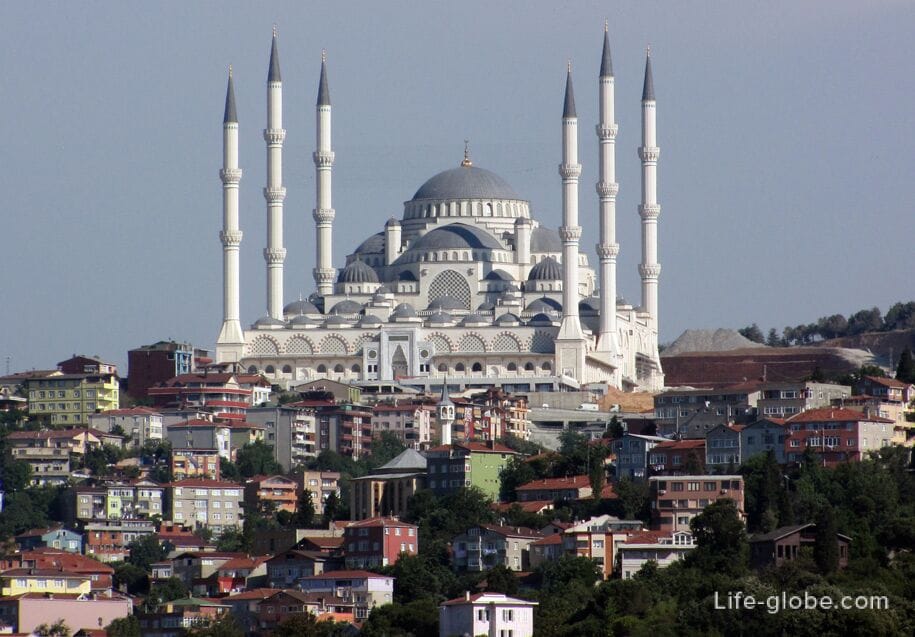
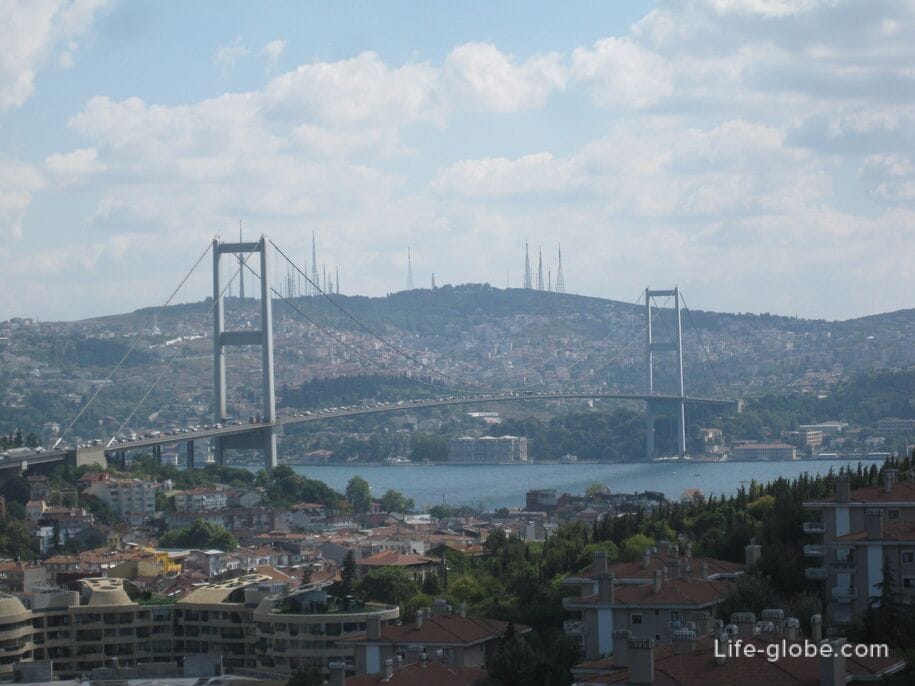
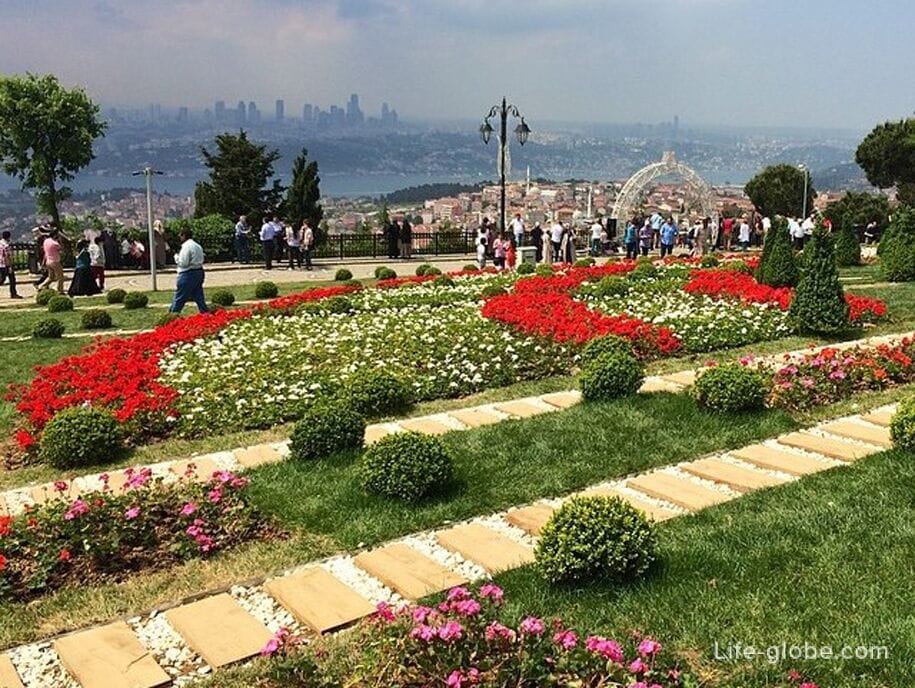
Mihrimah Sultan Mosque in Uskyudar
Mihrimah Sultan Mosque in Uskyudar (Mihrimah Sultan Camii) is an Ottoman mosque of the 16th century, built by order of Mihrimah Sultan, the daughter of Sultan Suleiman I and his wife Hurrem Sultan.
The open interior of the mosque is similar to the interior of Byzantine churches and early domed buildings of the Romans.
Between the buildings of the mosque and the madrasah, the graves of the two sons of Mihrimah and Rustem Pasha have been preserved. Not far from the mosque is the fountain of Sultan Ahmed III, built in 1728.
The mosque is located on the Asian side of Istanbul, in the Usküdar district.
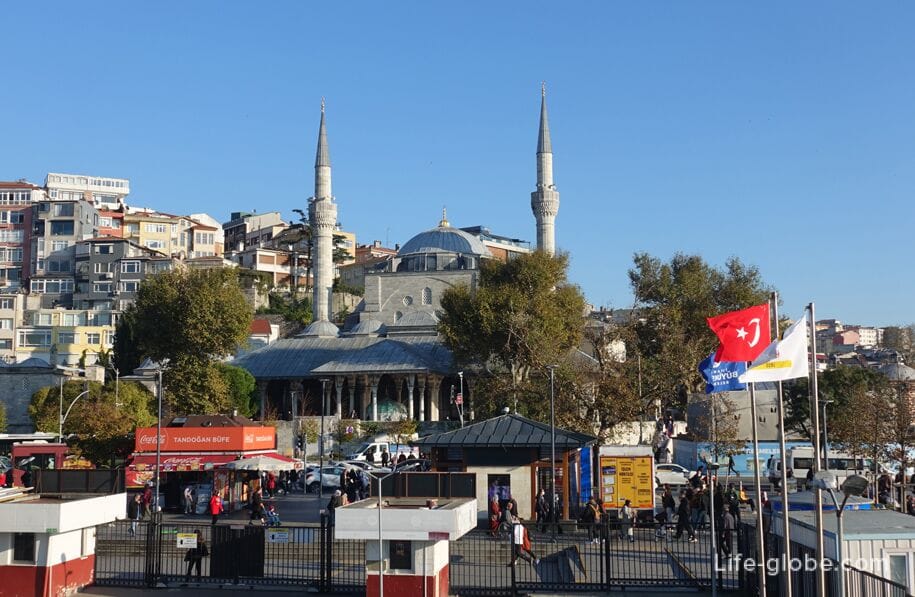
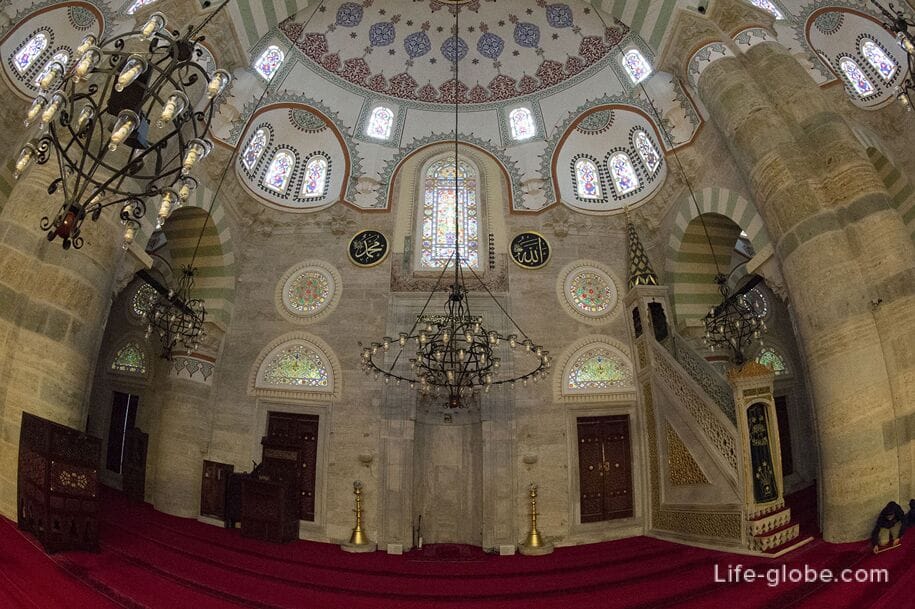
Shemsi Ahmed Pasha Mosque
The mosque of Shemsi Ahmed Pasha (Şemsi Ahmed Paşa Camii) is another masterpiece of Istanbul, which, like the Ortakoy Mosque, is located near the waters of the Bosphorus and is very photographed.
They say that birds never land on this mosque, and this is due to the fact that the architect of the mosque, Sinan, designed it so that the roof of the mosque was exactly at the intersection of the winds, which birds are not able to cope with.
The mosque was built in 1580 at the expense of the ruler of Anatolia and Rumelia - Shemsi Ahmed Pasha.
The mausoleum of Shemsi Ahmed Pasha adjoins the mosque. The mosque complex also includes: madrasah, cemetery and courtyard. A minaret is attached to the southwest corner of the prayer hall.
The mosque is located on the Asian side of Istanbul, in the Usküdar district, not far from the famous Maiden Tower (Kız Kulesi).
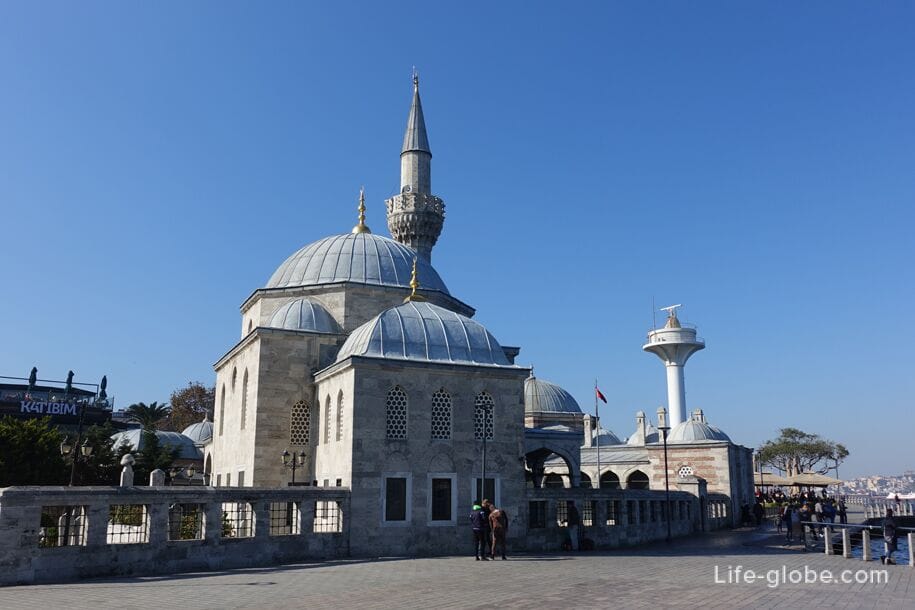
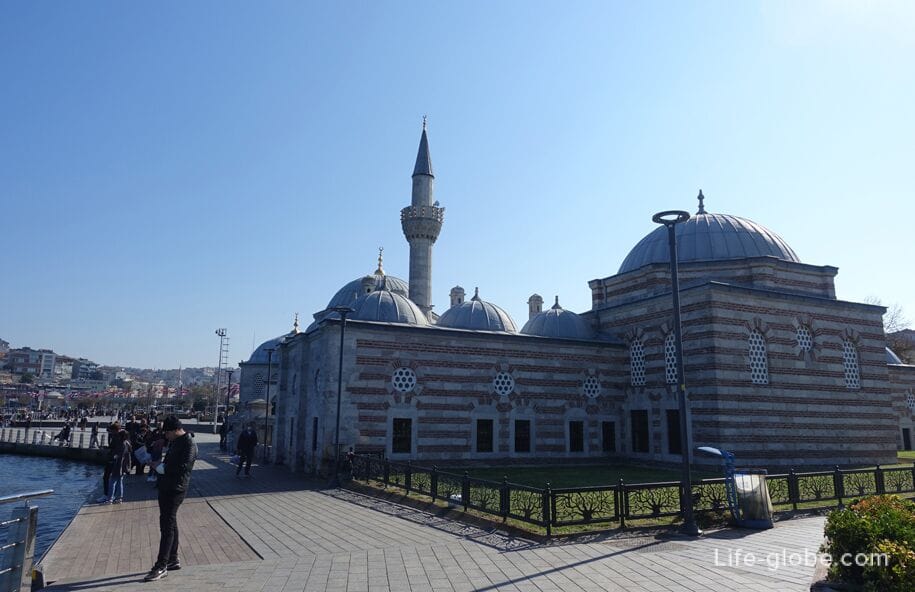
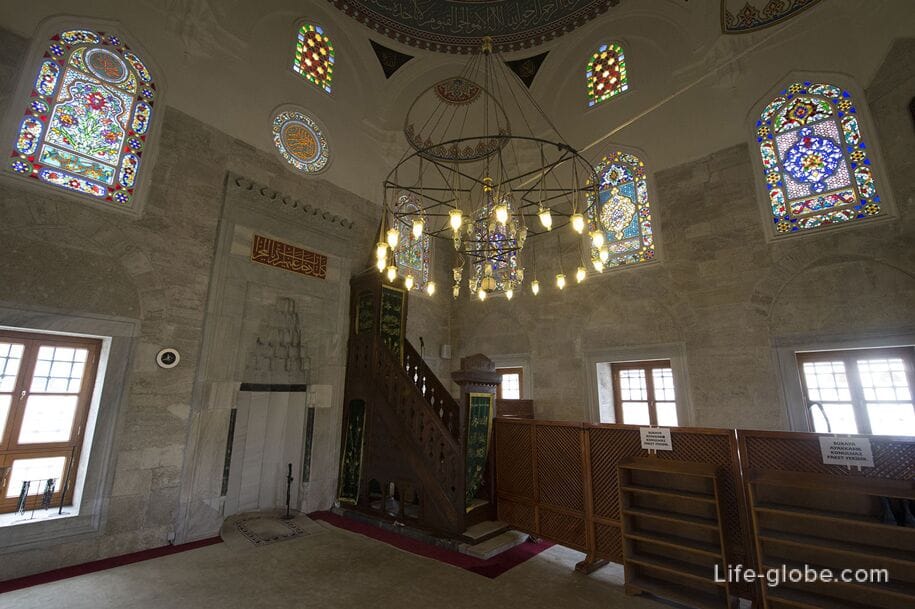
P.S. In addition to these, there are other mosques, churches and cathedrals in Istanbul, many of which are located in the most visited areas of the city, which also contain almost all the sights and museums of Istanbul. These are the districts: Fatih, Beyoglu (Beyoğlu), Besiktas (Beşiktaş), Shishli (Şişli), Usküdar (Üsküdar), Anadolu Hisary and Geksu (Anadolu Hisarı, Göksu).
Attention!
Before visiting a particular shrine in Istanbul, we recommend checking its opening hours and visiting conditions.
Tourists are not allowed to visit mosques during namaz.
When visiting mosques, the knees and shoulders should be covered, and women's heads should be covered. In many mosques, you can take shawls and capes at the entrance.
Entrance to all mosques is free.
All accommodation facilities in Istanbul, including in the historical center, on the European and Asian sides of the city, can be viewed and booked here




